1. House Finch (Haemorhous mexicanus)
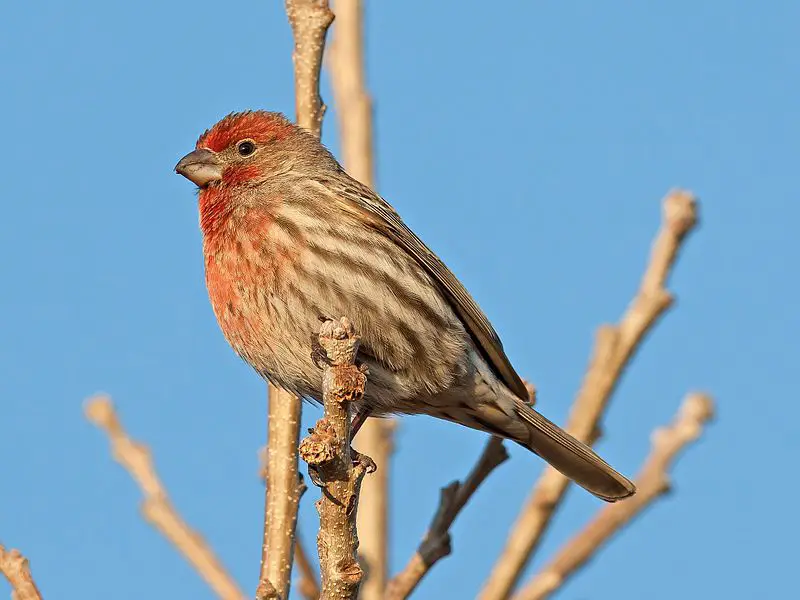
The House Finch, scientifically named Haemorhous mexicanus, is a small songbird widely known for its vibrant red plumage in males and its melodic song.
Originally native to western North America, this species has expanded its range to cover most of the continent. Males are easily identifiable by their bright red heads and breasts, while females and young birds display a more subdued, brown-streaked coloration.
House Finches primarily feed on grains, seeds, and fruits, and they are often seen at bird feeders. These birds are adaptable and thrive in various habitats, including urban areas, where they often nest in buildings or other structures.
| Kingdom | Animalia |
| Phylum | Chordata |
| Clade | Dinosauria |
| Class | Aves |
| Order | Passeriformes |
| Family | Fringillidae |
| Genus | Haemorhous |
| Species | H. mexicanus |
2. Dark-Eyed Junco (Junco hyemalis)
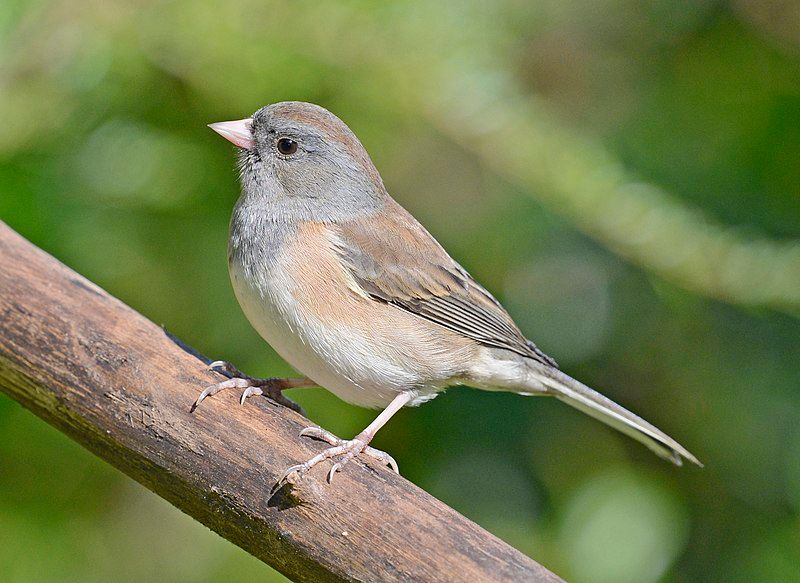
| Kingdom | Animalia |
| Phylum | Chordata |
| Clade | Dinosauria |
| Class | Aves |
| Order | Passeriformes |
| Family | Passerellidae |
| Genus | Junco |
| Species | J. hyemalis |
3. Downy Woodpecker (Dryobates pubescens)
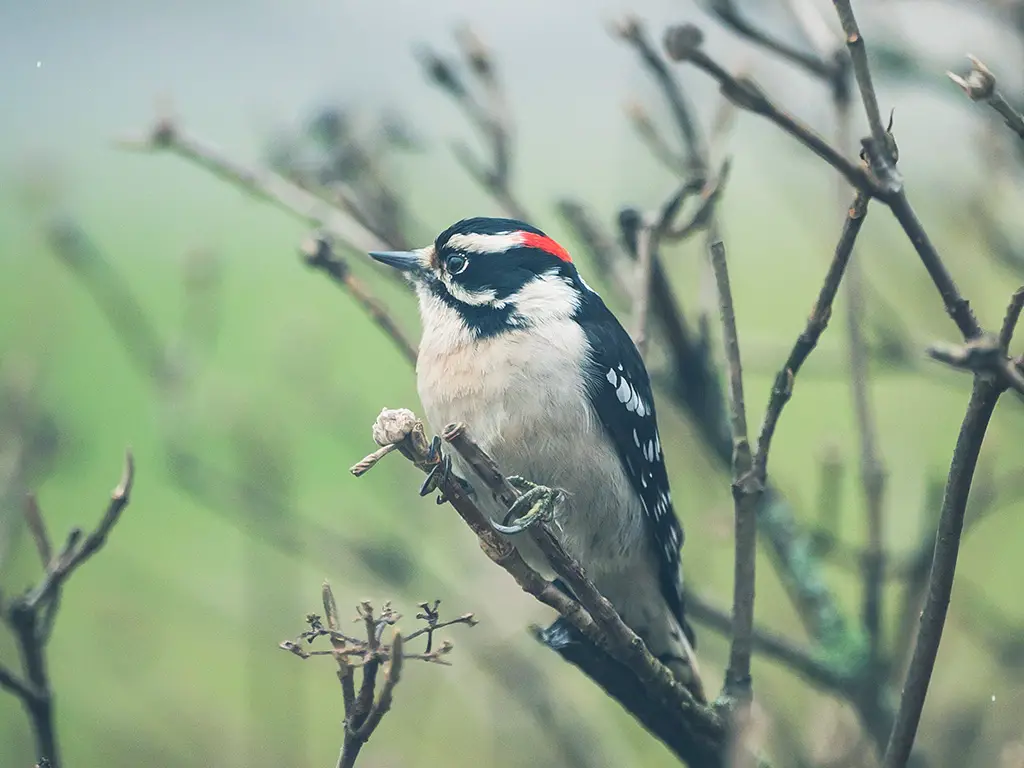
The Downy Woodpecker, Dryobates pubescens, is the smallest woodpecker in North America. This bird is easily identified by its distinctive black and white plumage, with males sporting a red patch on the back of their heads.
They inhabit woodlands, gardens, and parks across North America, often seen clinging to tree trunks and branches as they forage for insects. Their presence is also notable by their characteristic drumming on trees and wooden structures.
Downy Woodpeckers are known for their adaptability, often visiting bird feeders for suet and seeds, making them a common sight in backyard birdwatching.
| Kingdom | Animalia |
| Phylum | Chordata |
| Clade | Dinosauria |
| Class | Aves |
| Order | Piciformes |
| Family | Picidae |
| Genus | Dryobates |
| Species | D. pubescens |
4. American Goldfinch (Spinus tristis)

The American Goldfinch, Spinus tristis, is known for its vibrant yellow plumage in males during the breeding season and olive-brown winter coloration.
These small and lively birds are often seen in flocks, frequenting feeders and fields across North America. Their diet primarily consists of seeds, particularly from thistles, which also serve as material for their intricately woven nests.
The American Goldfinch is unique in its late breeding season, timed to coincide with the abundance of seed plants. Their cheerful, twittering song and undulating flight pattern make them a joy to observe.
| Kingdom | Animalia |
| Phylum | Chordata |
| Clade | Dinosauria |
| Class | Aves |
| Order | Passeriformes |
| Family | Fringillidae |
| Genus | Spinus |
| Species | S. tristis |
5. Black-Capped Chickadee (Poecile atricapillus)
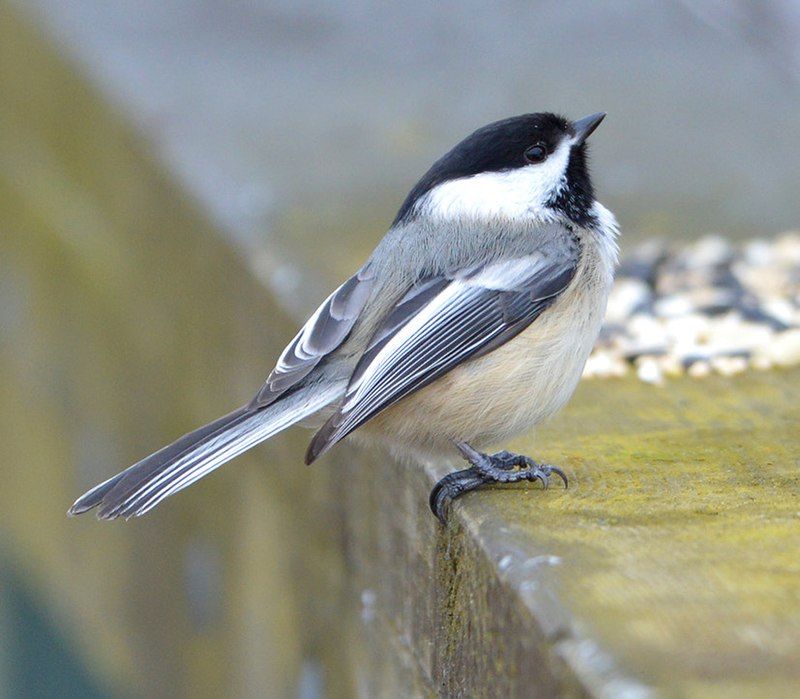
The Black-Capped Chickadee, Poecile atricapillus, is a small, charismatic bird recognized by its black cap and bib, white cheeks, and soft gray wings and back.
This species is widely found across North America, particularly in wooded areas, parks, and backyards.
Black-Capped Chickadees are known for their curiosity and boldness, often approaching humans and readily taking food from feeders.
Their distinctive “chick-a-dee-dee-dee” call is a familiar sound in their habitats. These birds are also notable for their excellent memory, which helps them locate food caches during winter months.
| Kingdom | Animalia |
| Phylum | Chordata |
| Clade | Dinosauria |
| Class | Aves |
| Order | Passeriformes |
| Family | Paridae |
| Genus | Poecile |
| Species | P. atricapillus |
6. American Robin (Turdus migratorius)
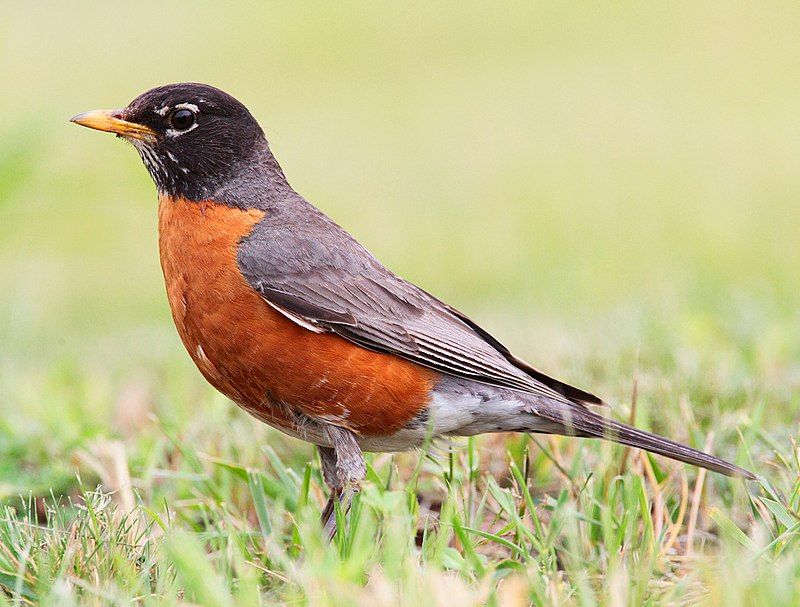
The American Robin, Turdus migratorius, is one of North America’s most recognizable and widespread birds. Known for their bright red or orange breasts, gray backs, and melodious songs, these birds are a symbol of spring.
American Robins are often found hopping across lawns, gardens, and parks, foraging for earthworms, insects, and fruit. They are early nesters, with females constructing nests from twigs, grass, and mud.
Their cheerful song at dawn and dusk and their presence in diverse habitats, from forests to urban areas, make them a beloved and familiar sight.
| Kingdom | Animalia |
| Phylum | Chordata |
| Clade | Dinosauria |
| Class | Aves |
| Order | Passeriformes |
| Family | Turdidae |
| Genus | Turdus |
| Species | T. migratorius |
7. Red-Breasted Nuthatch (Sitta canadensis)
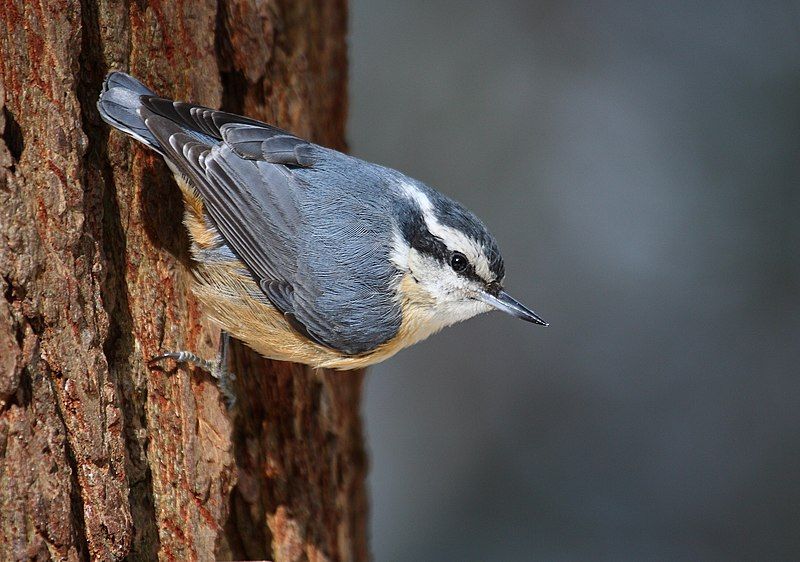
| Kingdom | Animalia |
| Phylum | Chordata |
| Clade | Dinosauria |
| Class | Aves |
| Order | Passeriformes |
| Family | Sittidae |
| Genus | Sitta |
| Species | S. canadensis |
8. Mountain Chickadee (Poecile gambeli)
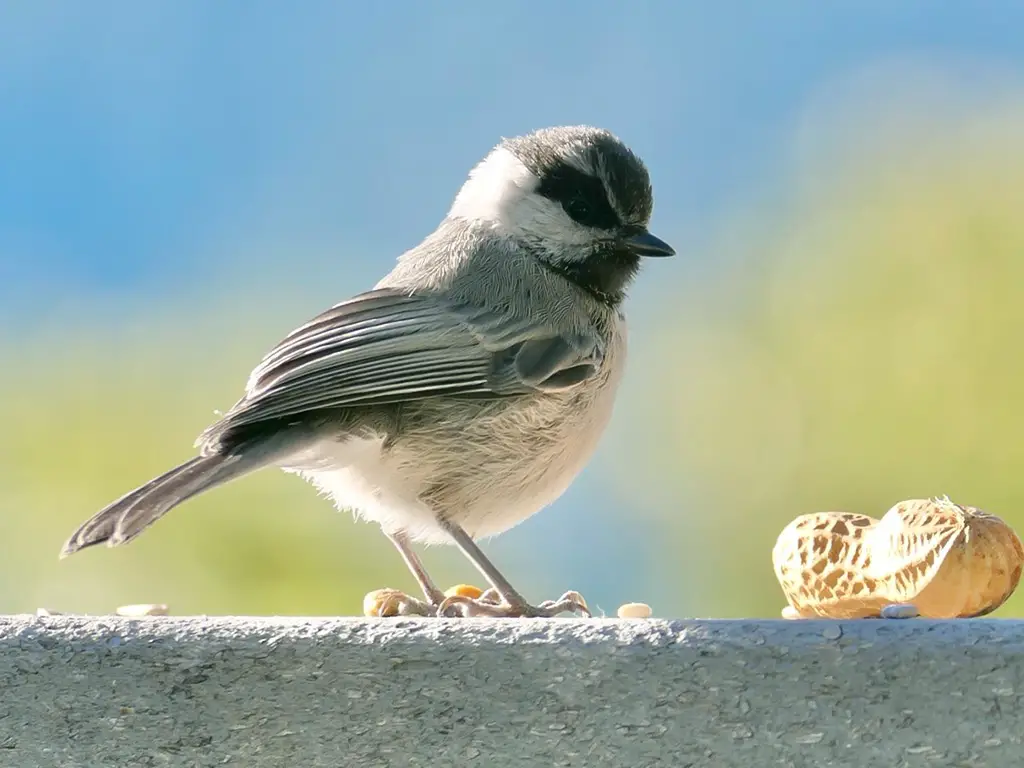
The Mountain Chickadee, Poecile Gambeli, is a small, active bird easily recognized by its distinctive black cap and white eyebrow stripe.
Native to the mountainous regions of western North America, these birds thrive in coniferous and mixed forests.
They are known for their curious nature and acrobatic feeding habits, often seen hanging upside down on branches as they search for insects and seeds.
The Mountain Chickadee’s clear and whistled “fee-bee” call is a familiar sound in its habitat. These birds are also adept at storing food for later use, showcasing remarkable memory abilities.
| Kingdom | Animalia |
| Phylum | Chordata |
| Clade | Dinosauria |
| Class | Aves |
| Order | Passeriformes |
| Family | Paridae |
| Genus | Poecile |
| Species | P. gambeli |
9. Pine Siskin (Spinus pinus)
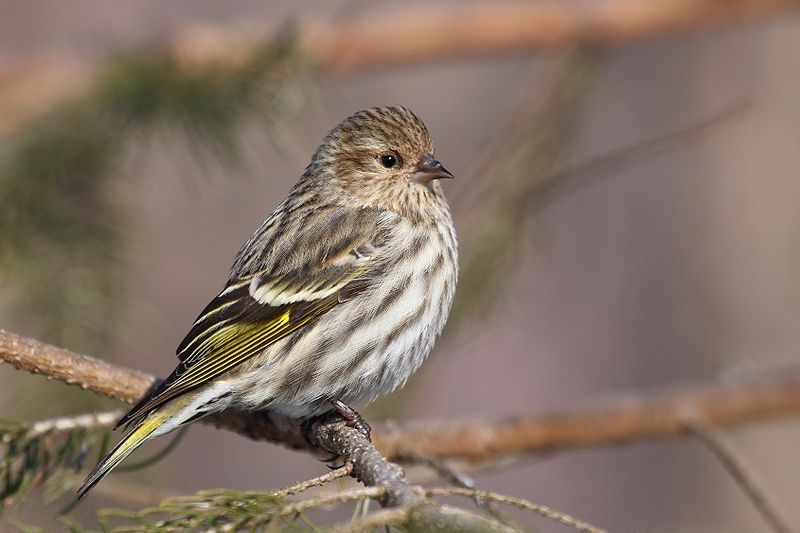
The Pine Siskin, Spinus pinus, is a small, brown-streaked finch with flashes of yellow in its wings and tail.
These birds are nomadic, moving unpredictably across North America in response to food availability.
Pine Siskins primarily feed on seeds, especially from conifers, and are often seen in flocks, sometimes mixing with other finch species.
They have a distinctive, buzzy call and a rapid, undulating flight pattern. Despite their small size, Pine Siskins are known for being feisty, often dominating bird feeders.
| Kingdom | Animalia |
| Phylum | Chordata |
| Clade | Dinosauria |
| Class | Aves |
| Order | Passeriformes |
| Family | Fringillidae |
| Genus | Spinus |
| Species | S. pinus |
10. Common Starling (Sturnus vulgaris)
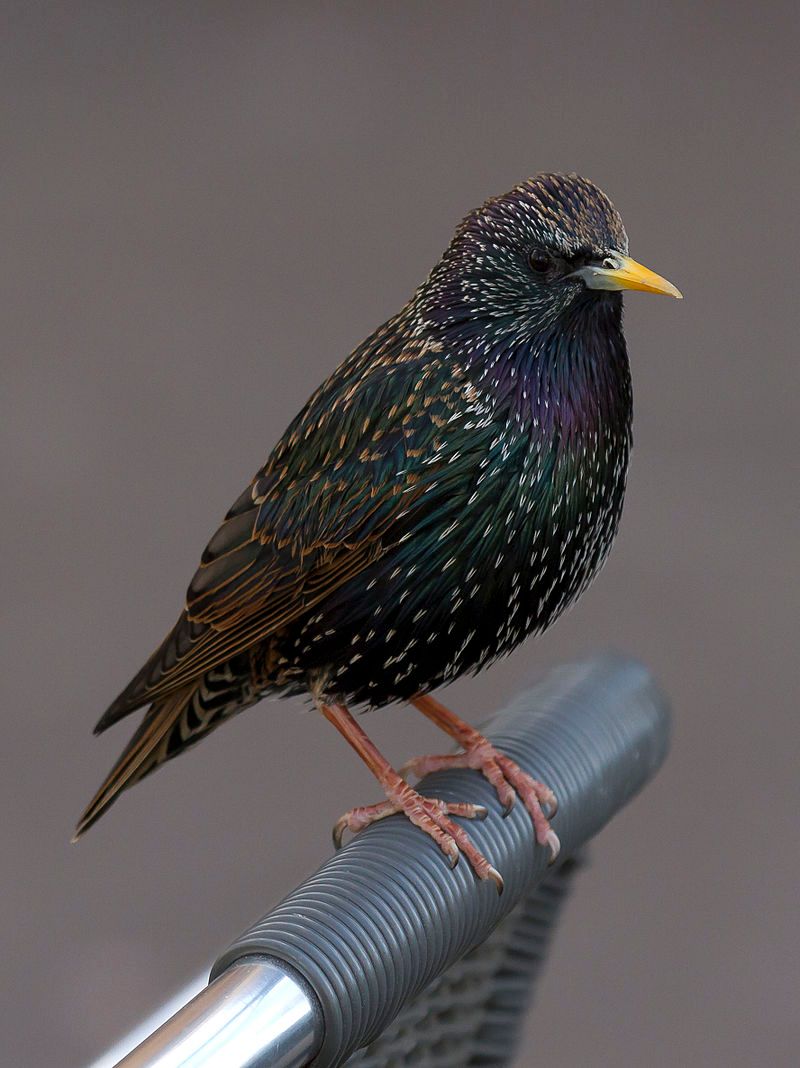
The Common Starling, Sturnus vulgaris, is an easily recognizable bird with iridescent black plumage speckled with white during the winter.
Native to Eurasia, this species has been introduced to various regions, including North America, where it is now widespread.
Common Starlings are adaptable, thriving in urban and rural areas, and are often seen foraging in lawns and fields for insects and fruits.
They are known for their vocal abilities, mimicking sounds and other bird calls. In the evening, they often form large, mesmerizing flocks called murmurations, creating fluid, shifting shapes in the sky.
| Kingdom | Animalia |
| Phylum | Chordata |
| Clade | Dinosauria |
| Class | Aves |
| Order | Passeriformes |
| Family | Sturnidae |
| Genus | Sturnus |
| Species | S. vulgaris |
11. Northern Flicker (Colaptes auratus)
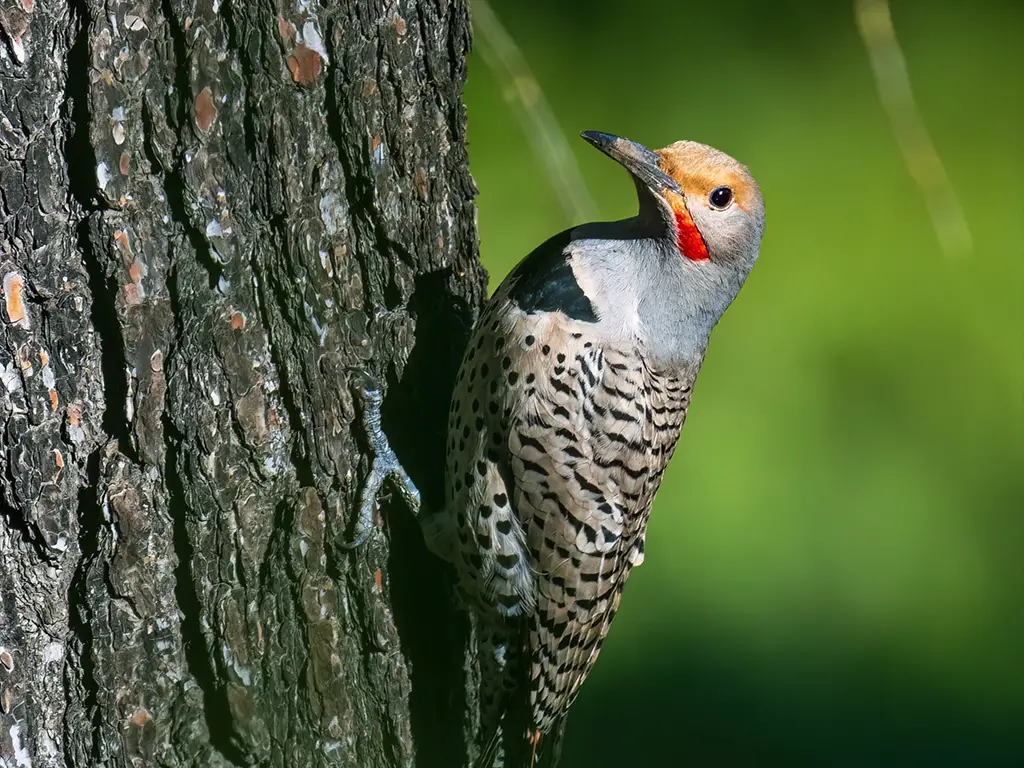
The Northern Flicker, Colaptes auratus, is a large, brown woodpecker with a distinctive barred back and spotted belly.
In North America, there are two primary forms: the yellow-shafted in the east and the red-shafted in the west. Unlike other woodpeckers, Northern Flickers often forage on the ground for ants and beetles.
Their loud calls, which include a sharp “wick-wick-wick” and loud drumming on trees and metal surfaces, are characteristic sounds in their habitats. These birds are also known for their prominent, circular flight pattern.
| Kingdom | Animalia |
| Phylum | Chordata |
| Clade | Dinosauria |
| Class | Aves |
| Order | Piciformes |
| Family | Picidae |
| Genus | Colaptes |
| Species | C. auratus |
12. Eurasian Collared Dove (Streptopelia decaocto)
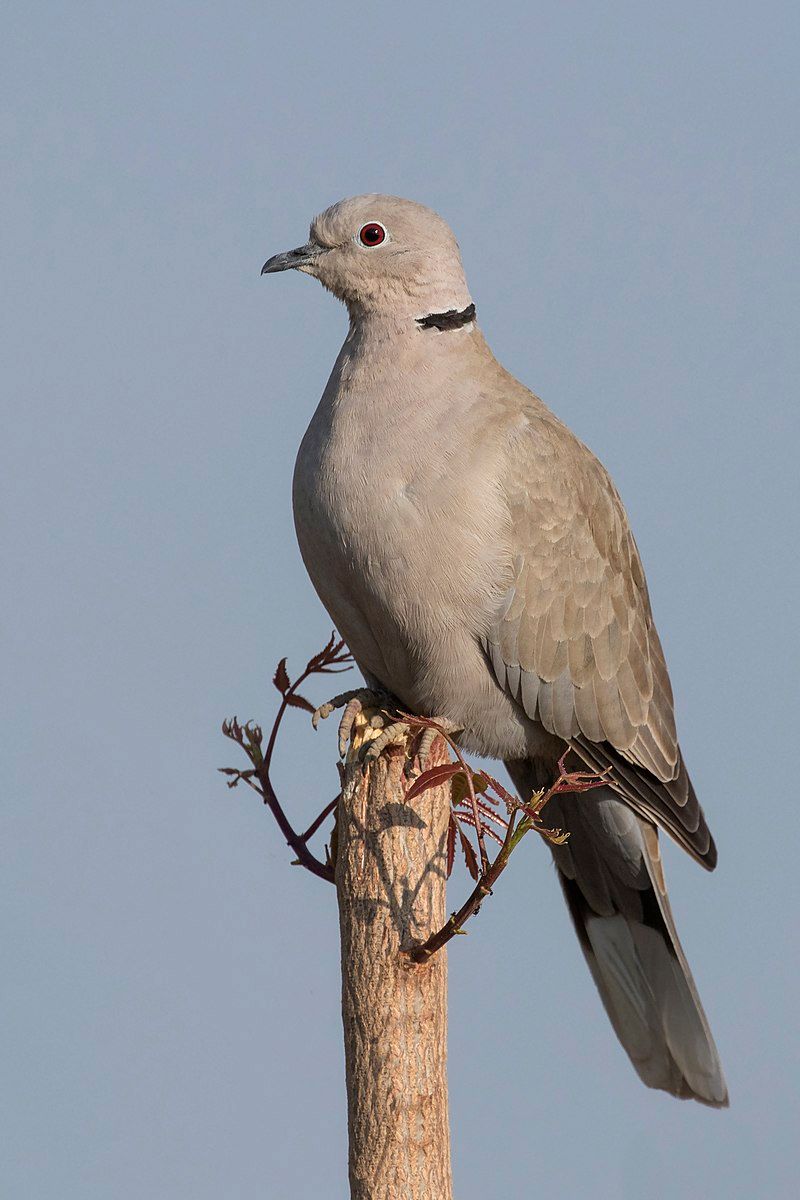
The Eurasian Collared Dove, Streptopelia decaocto, is a large, pale gray dove with a distinctive black neck collar. Originally from Asia and Europe, this species has rapidly expanded its range and is now common in many parts of North America.
These doves are often seen in pairs or small groups, frequenting bird feeders and foraging on the ground for seeds and grains. They have a repetitive, three-syllable cooing call.
The Eurasian Collared Dove is known for its ability to adapt to various habitats, including urban environments.
| Kingdom | Animalia |
| Phylum | Chordata |
| Clade | Dinosauria |
| Class | Aves |
| Order | Columbiformes |
| Family | Columbidae |
| Genus | Streptopelia |
| Species | S. decaocto |
13. Rock Dove (Columba livia)
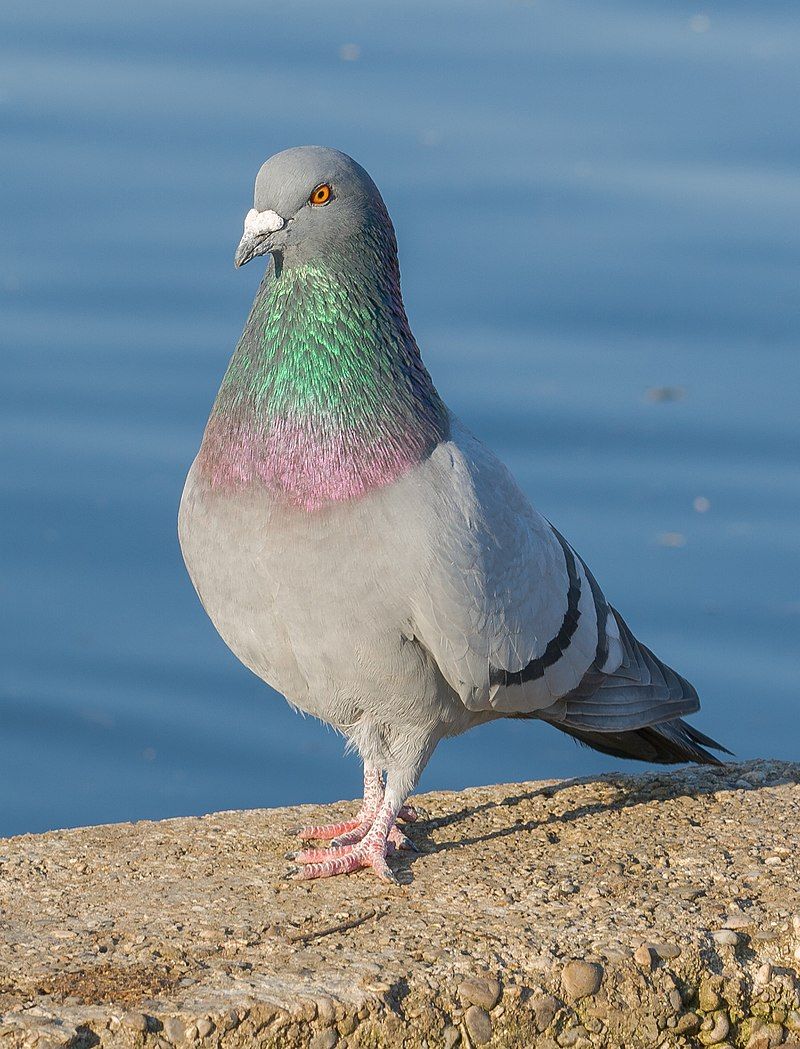
| Kingdom | Animalia |
| Phylum | Chordata |
| Clade | Dinosauria |
| Class | Aves |
| Order | Columbiformes |
| Family | Columbidae |
| Genus | Columba |
| Species | C. livia |
14. American Crow (Corvus brachyrhynchos)
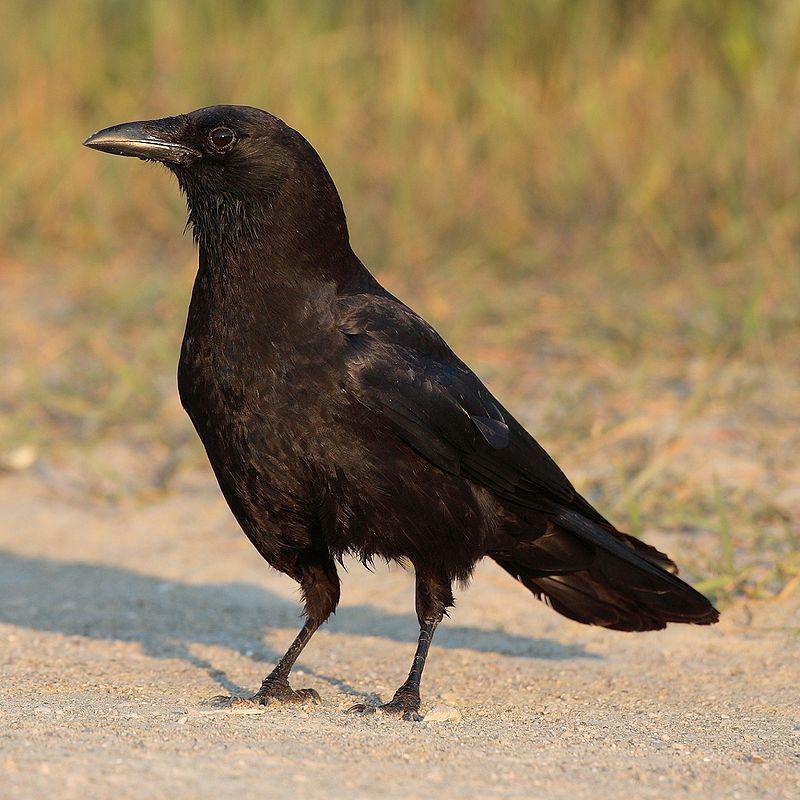
The American Crow, Corvus brachyrhynchos, is a large, intelligent, and adaptable bird found throughout North America. Recognized for their all-black plumage and distinctive cawing call, these birds are highly social and often seen in groups.
American Crows are omnivorous and opportunistic feeders, consuming a wide range of food, including insects, seeds, fruits, and garbage.
Their problem-solving abilities and use of tools put them among the most intelligent of birds. They have a complex social structure and are known to recognize individual human faces.
Crows also participate in a behavior known as a “crow funeral,” where they gather around deceased members, speculated to be a way to learn about potential dangers.
| Kingdom | Animalia |
| Phylum | Chordata |
| Clade | Dinosauria |
| Class | Aves |
| Order | Passeriformes |
| Family | Corvidae |
| Genus | Corvus |
| Species | C. brachyrhynchos |
15. Black-Billed Magpie (Pica hudsonia)
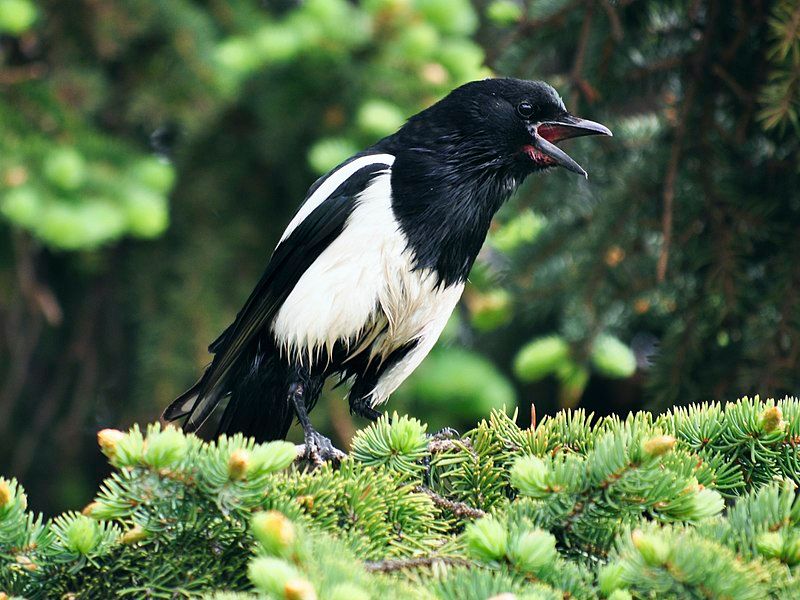
The Black-Billed Magpie, Pica hudsonia, is a striking bird native to western North America. Known for its long tail and contrasting black and white plumage, with iridescent blue-green wing and tail feathers, this bird is both beautiful and easily identifiable.
Black-Billed Magpies are highly intelligent and curious, often observed manipulating objects and mimicking sounds.
They are omnivorous, eating various foods, from insects and carrion to grains and fruits. Their nests are large, dome-shaped structures built high in trees or tall shrubs.
These birds are often seen walking on the ground with a swaggering gait and are known for their loud, chattering calls.
| Kingdom | Animalia |
| Phylum | Chordata |
| Clade | Dinosauria |
| Class | Aves |
| Order | Passeriformes |
| Family | Corvidae |
| Genus | Pica |
| Species | P. hudsonia |
16. Red-Tailed Hawk (Buteo jamaicensis)
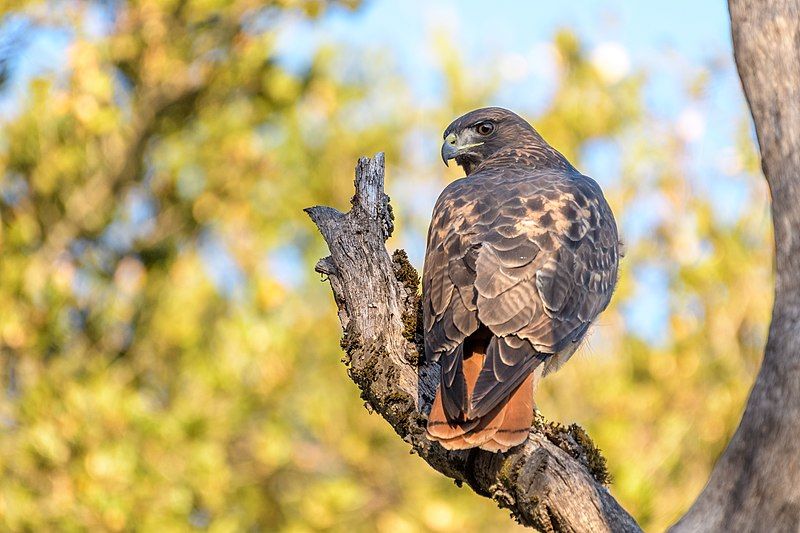
The Red-Tailed Hawk, Buteo jamaicensis, is one of North America’s most common and widespread hawks. This bird of prey is easily recognized by its broad, rounded wings, short, wide tail, and, in adults, a rich reddish-brown tail.
They inhabit a wide range of environments, from deserts and grasslands to forests and urban areas. Red-Tailed Hawks are known for their soaring flight and piercing screeches.
These raptors primarily feed on small mammals, birds, and reptiles, often seen perched along highways and other high vantage points scanning for prey.
Their adaptability to different habitats and presence near human settlements make them one of the most observed raptors.
| Kingdom | Animalia |
| Phylum | Chordata |
| Clade | Dinosauria |
| Class | Aves |
| Order | Accipitriformes |
| Family | Accipitridae |
| Genus | Buteo |
| Species | B. jamaicensis |
17. Gray-Crowned Rosy Finch (Leucosticte tephrocotis)
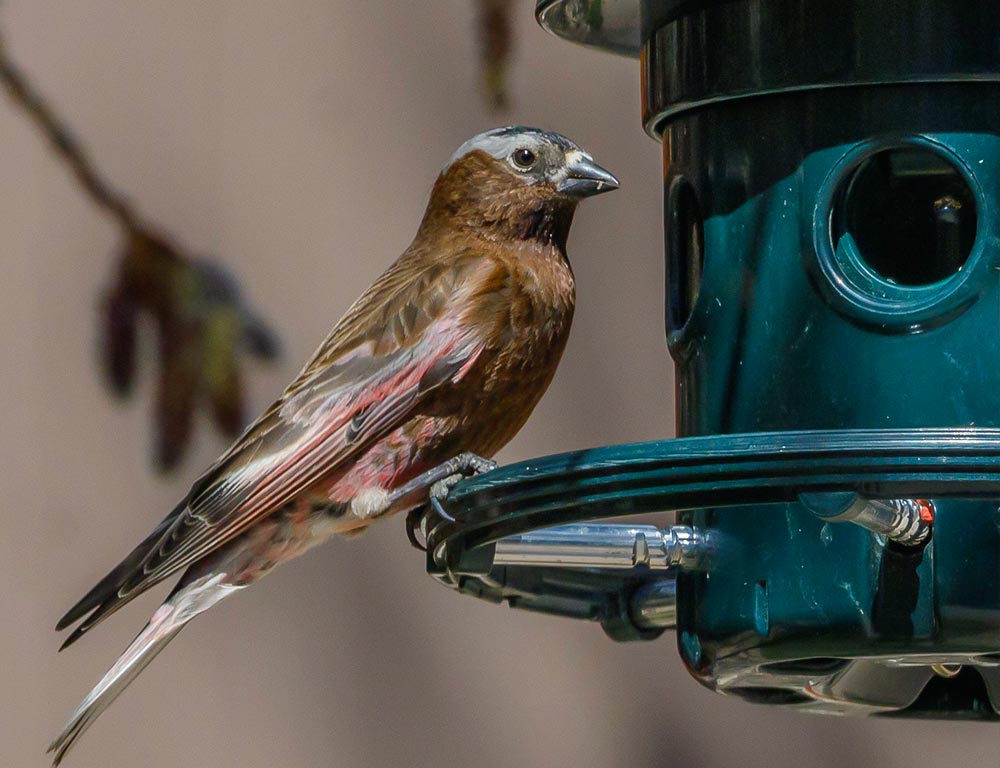
The Gray-Crowned Rosy Finch, Leucosticte tephrocotis, is a hardy bird found in the alpine regions of western North America. These finches have a distinctive appearance: gray head and back, pink breast and belly, and black tail.
They are one of the highest-altitude breeding birds in North America, nesting in rocky crevices and foraging for seeds and insects on snowfields and tundra.
Gray-crowned rosy Finches are known for their resilience to cold climates and their flocking behavior, often seen in large groups during winter. Their soft, warbling song is delightful in their harsh, mountainous habitats.
| Kingdom | Animalia |
| Phylum | Chordata |
| Clade | Dinosauria |
| Class | Aves |
| Order | Passeriformes |
| Family | Fringillidae |
| Genus | Leucosticte |
| Species | L. tephrocotis |
18. Rough-Legged Buzzard (Buteo lagopus)
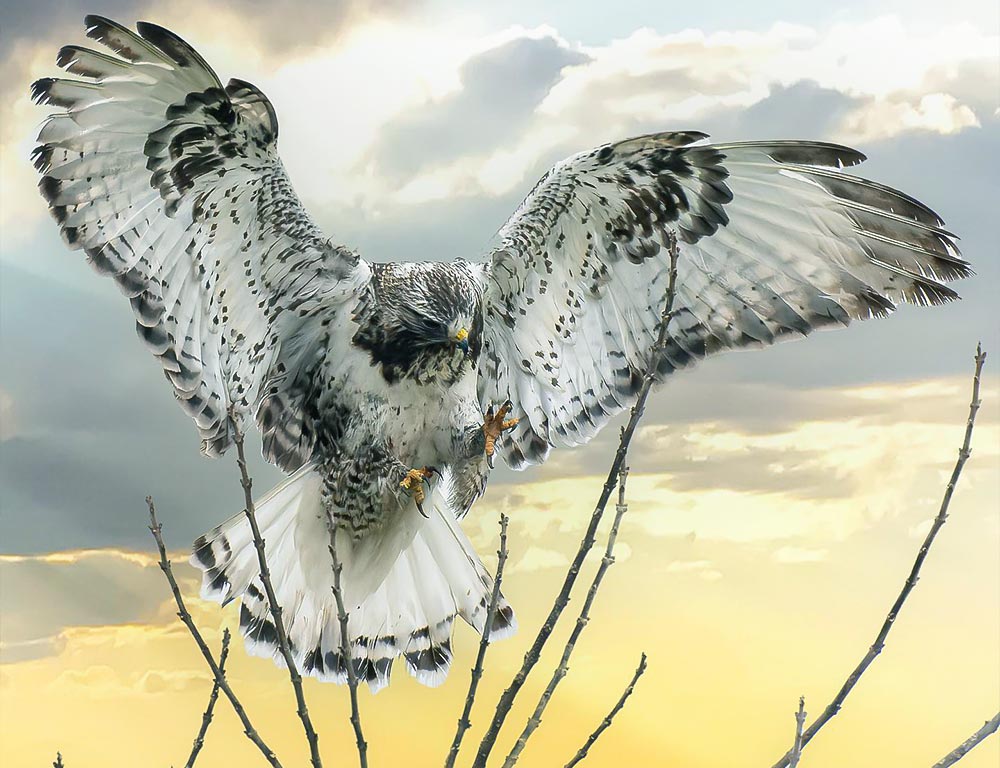
| Kingdom | Animalia |
| Phylum | Chordata |
| Clade | Dinosauria |
| Class | Aves |
| Order | Accipitriformes |
| Family | Accipitridae |
| Genus | Buteo |
| Species | B. lagopus |
19. Cedar Waxwing (Bombycilla cedrorum)
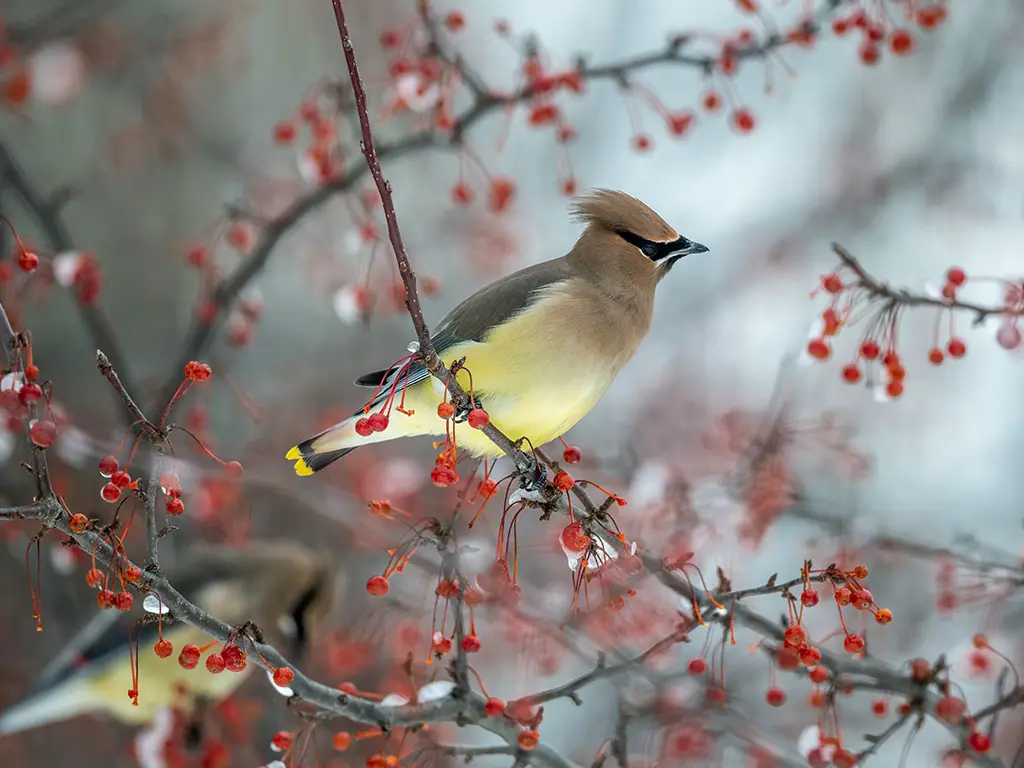
The Cedar Waxwing, Bombycilla cedrorum, is a sleek, medium-sized bird known for its polished plumage and unique red wax-like tips on its wing feathers.
They exhibit a blend of soft gray, pale yellow, and brown colors, with a distinctive black mask and a crest on their head.
Cedar Waxwings are highly social birds, often seen in large flocks, particularly near sources of berries, their primary food source. Their diet also includes insects during the breeding season.
These birds are known for their high-pitched, trilling calls and are often found in wooded areas, especially those with fruit-bearing trees and shrubs.
Cedar Waxwings are also notable for their unique courtship behavior, passing small objects like berries or flower petals back and forth.
| Kingdom | Animalia |
| Phylum | Chordata |
| Clade | Dinosauria |
| Class | Aves |
| Order | Passeriformes |
| Family | Bombycillidae |
| Genus | Bombycilla |
| Species | B. cedrorum |
20. Canada Goose (Branta canadensis)
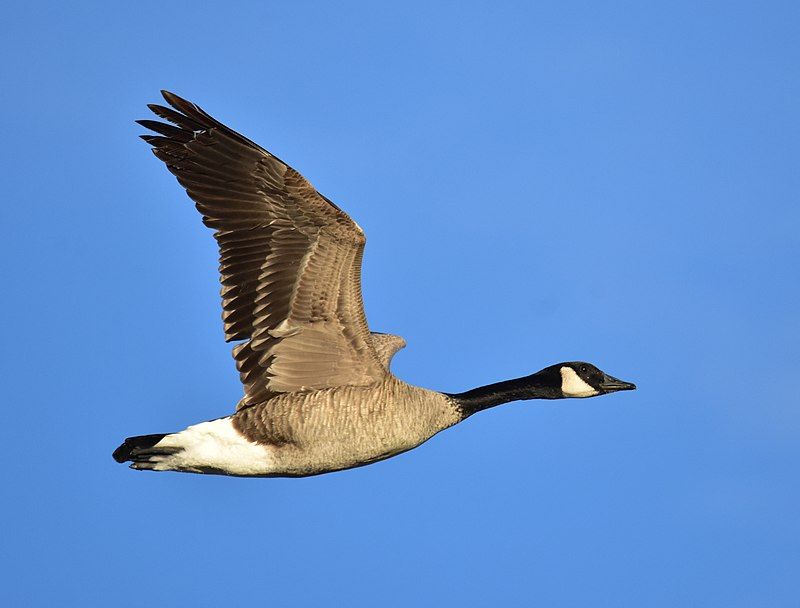
The Canada Goose, Branta canadensis, is a large, recognizable bird with a black head, neck, white cheeks, and brown body. Known for their loud, honking call and V-shaped flying pattern, Canada Geese are familiar in many parts of North America.
They are adaptable and can be found in various habitats, including lakes, rivers, ponds, and urban parks. Canada Geese are primarily herbivorous, grazing on grasses, grains, and aquatic plants.
They are also known for their strong family bonds and cooperative parenting, with both parents involved in raising the young. During migration, their impressive flocks and long-distance flying abilities make them a symbol of the changing seasons.
| Kingdom | Animalia |
| Phylum | Chordata |
| Clade | Dinosauria |
| Class | Aves |
| Order | Anseriformes |
| Family | Anatidae |
| Genus | Branta |
| Species | B. canadensis |
21. Common Goldeneye (Bucephala clangula)
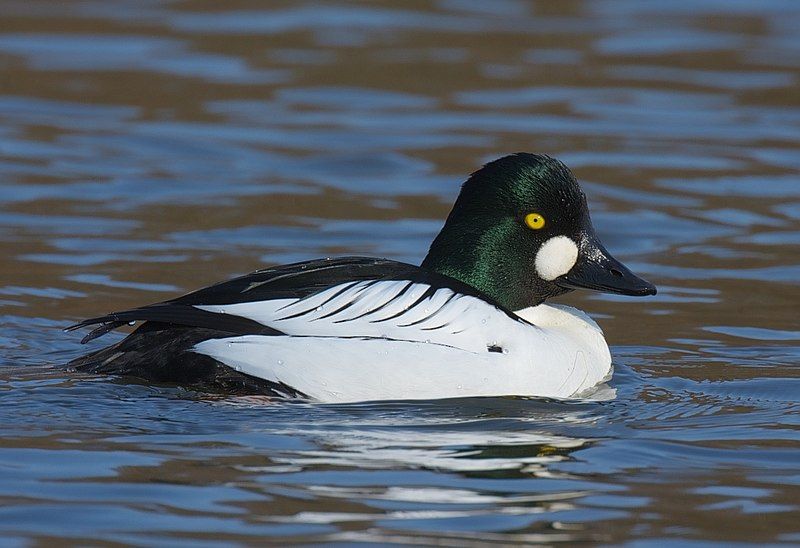
The Common Goldeneye, Bucephala clangula, is a medium-sized duck known for its striking appearance. The male has a glossy green-black head, a white body, and a distinctive golden-yellow eye, while the female is gray-brown with a similar golden eye.
These ducks are found in the lakes and rivers of boreal forests across Canada, the northern United States, and parts of Europe and Asia. They are excellent divers, feeding on aquatic invertebrates and fish.
Common Goldeneyes are also notable for their distinctive courtship displays, involving head tossing and vocalizations. During winter, they migrate to more temperate coastal waters, often forming large flocks.
| Kingdom | Animalia |
| Phylum | Chordata |
| Clade | Dinosauria |
| Class | Aves |
| Order | Anseriformes |
| Family | Anatidae |
| Genus | Bucephala |
| Species | B. clangula |
22. Mourning Dove (Zenaida macroura)
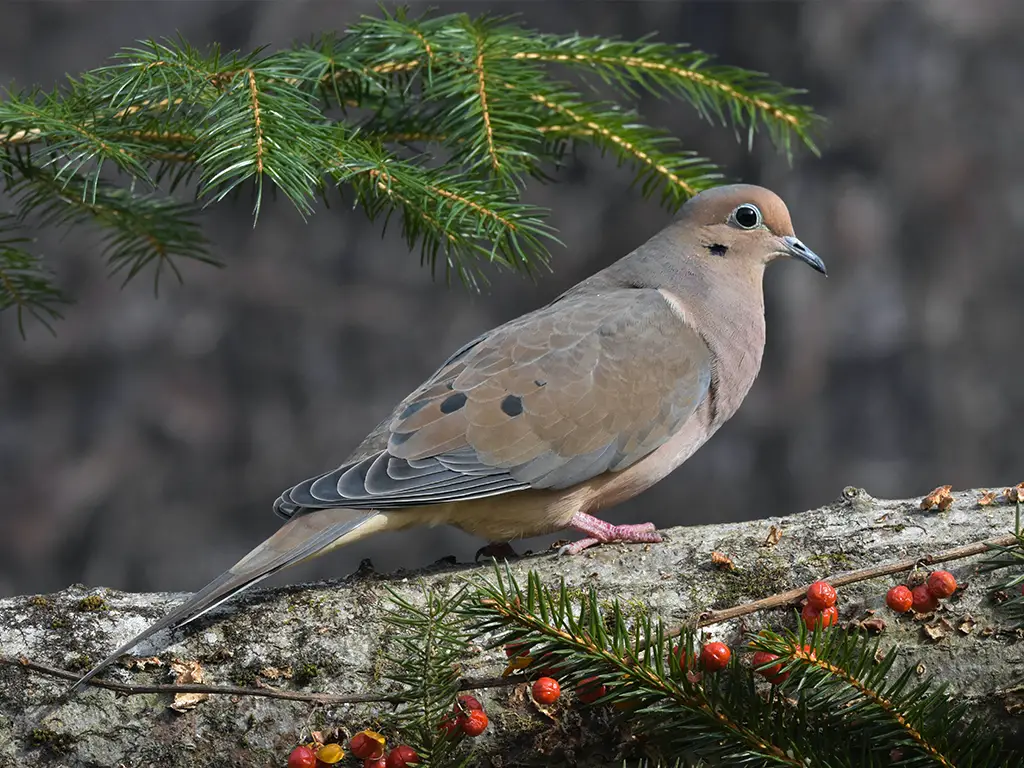
The Mourning Dove, Zenaida macroura, is a slender, graceful bird with a soft gray-brown body, black spots on the wings, and a long, pointed tail with white edges.
These birds are widespread across North America and are known for their gentle, mournful cooing, which gives them their name.
Mourning Doves are primarily seed eaters and can be found in open and semi-open habitats, including urban areas.
They are fast fliers and exhibit a distinctive whistling sound created by their wings during takeoff and landing.
Mourning Doves are monogamous and known for their strong pair bonds, often seen perching close together on wires or branches.
| Kingdom | Animalia |
| Phylum | Chordata |
| Clade | Dinosauria |
| Class | Aves |
| Order | Columbiformes |
| Family | Columbidae |
| Genus | Zenaida |
| Species | Z. macroura |
23. Song Sparrow (Melospiza melodia)
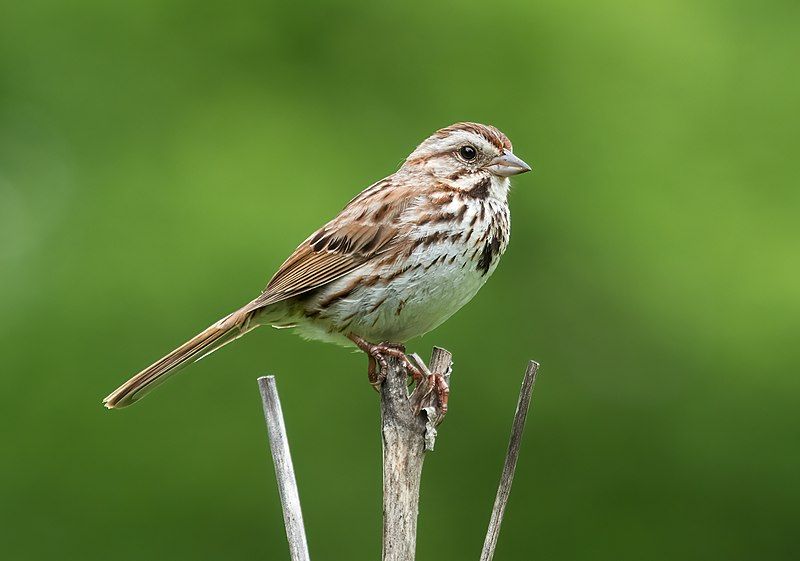
| Kingdom | Animalia |
| Phylum | Chordata |
| Clade | Dinosauria |
| Class | Aves |
| Order | Passeriformes |
| Family | Passerellidae |
| Genus | Melospiza |
| Species | M. melodia |
24. Common Grackle (Quiscalus quiscula)
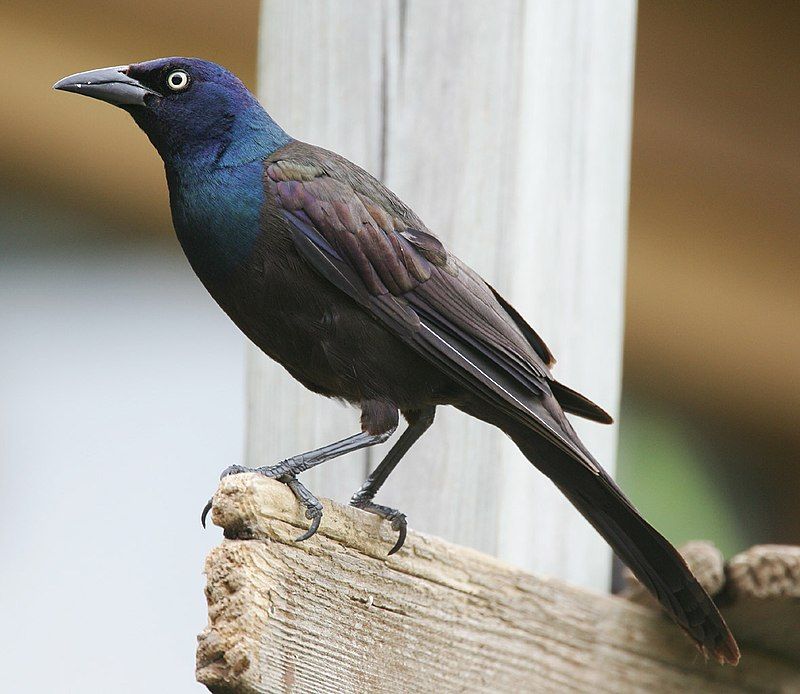
The Common Grackle, Quiscalus quiscula, is a large blackbird with a distinctive iridescent sheen to its plumage, often appearing blue, purple, or green in the light. They have a long, keel-shaped tail and a strong, straight bill.
Common Grackles are adaptable and often seen in large, noisy flocks in a variety of habitats, including farmlands, parks, and suburban areas. Their diet is diverse, including insects, seeds, grains, and even small vertebrates and garbage.
These birds are known for their intelligence and resourcefulness in finding food. Common Grackles can be aggressive, particularly during breeding season, and are often dominant at bird feeders. Their loud and varied calls, including whistles and clacks, are a familiar sound in their range.
| Kingdom | Animalia |
| Phylum | Chordata |
| Clade | Dinosauria |
| Class | Aves |
| Order | Passeriformes |
| Family | Icteridae |
| Genus | Quiscalus |
| Species | Q. quiscula |
25. Red-Winged Blackbird (Agelaius phoeniceus)
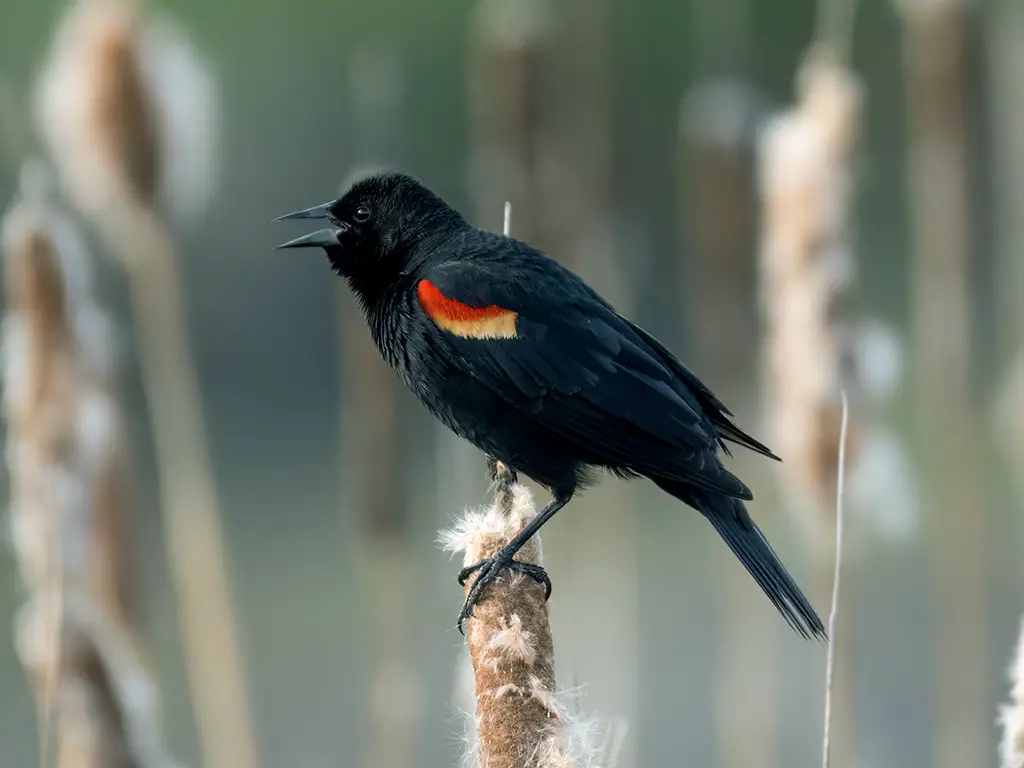
The Red-Winged Blackbird, Agelaius phoeniceus, is a striking bird, especially the male, with its glossy black plumage and bright red and yellow shoulder patches. Females are more subdued, with streaked brown plumage.
These birds are commonly found in North American wetlands, marshes, and meadows. They are highly social, often seen in large flocks, particularly in non-breeding season.
Red-winged blackbirds are omnivorous, feeding on seeds, grains, insects, and other small animals. Their song is a distinctive, liquid trill, often heard in spring and summer.
Males are territorial during breeding season and can be seen perched prominently, singing and displaying their red shoulder patches.
| Kingdom | Animalia |
| Phylum | Chordata |
| Clade | Dinosauria |
| Class | Aves |
| Order | Passeriformes |
| Family | Icteridae |
| Genus | Agelaius |
| Species | A. phoeniceus |
26. White-Crowned Sparrow (Zonotrichia leucophrys)
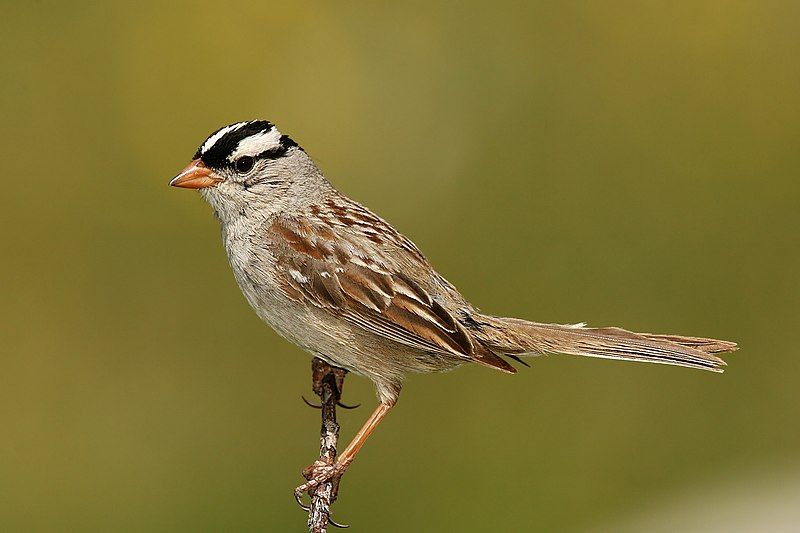
The White-Crowned Sparrow, Zonotrichia leucophrys, is a medium-sized sparrow with bold black and white stripes on its head, a gray face, and a brown-streaked body.
These birds are found across North America, inhabiting shrubby areas, gardens, and open woodlands.
White-Crowned Sparrows are ground feeders, eating seeds and insects, and are often seen hopping on the ground or in low vegetation.
Their song is a clear, sweet whistle, varying geographically, and is a common sound in their habitats, especially during breeding season.
These sparrows are also known for their long migratory journeys, traveling between their breeding grounds in the north and wintering areas in the south.
| Kingdom | Animalia |
| Phylum | Chordata |
| Clade | Dinosauria |
| Class | Aves |
| Order | Passeriformes |
| Family | Passerellidae |
| Genus | Zonotrichia |
| Species | Z. leucophrys |
27. Cassin’s Finch (Haemorhous cassinii)
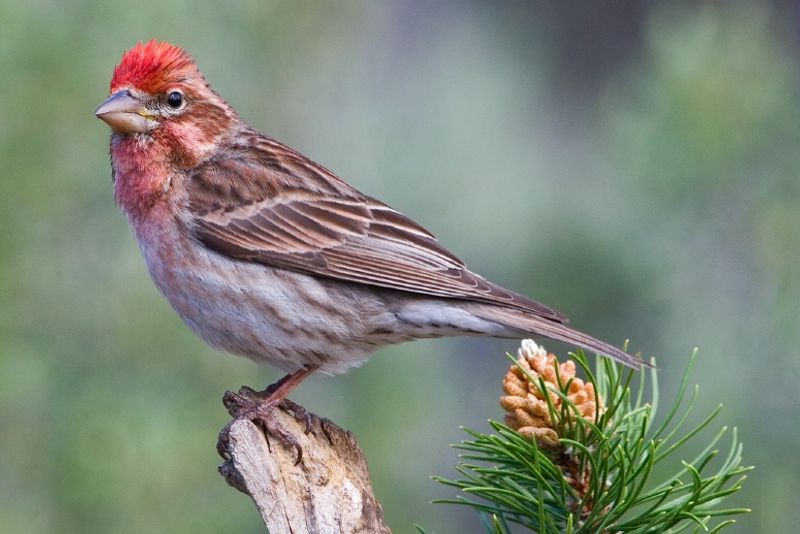
Cassin’s Finch, Haemorhous cassinii, is a small bird native to the mountains of western North America.
Males are notable for their rosy-red head and chest, while females and young birds have a brown-streaked appearance.
Cassin’s Finches are found in coniferous forests and mixed woodlands, feeding primarily on seeds, buds, and some insects.
They often visit bird feeders, especially in winter. These finches have a melodious song consisting of a series of rapid notes and trills.
Cassin’s Finches are known for resembling the closely related Purple Finch and House Finch, with subtle differences in plumage and song.
| Kingdom | Animalia |
| Phylum | Chordata |
| Clade | Dinosauria |
| Class | Aves |
| Order | Passeriformes |
| Family | Fringillidae |
| Genus | Haemorhous |
| Species | H. cassinii |
28. Evening Grosbeak (Coccothraustes vespertinus)
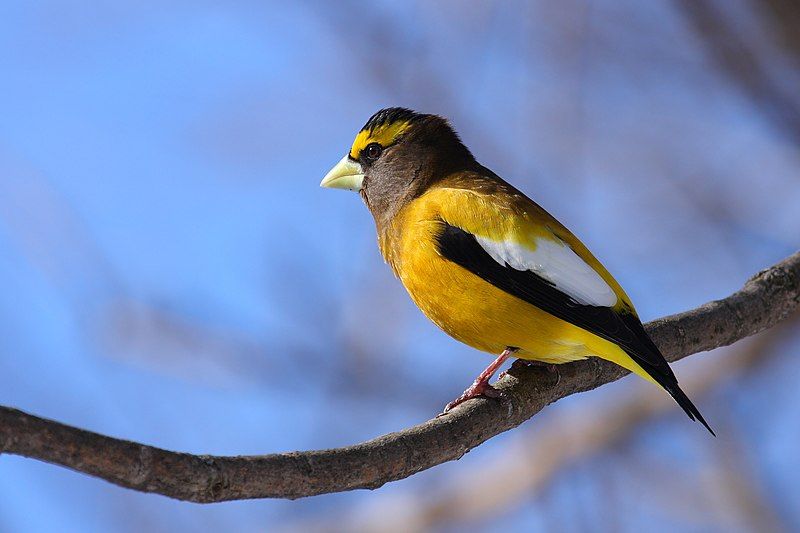
| Kingdom | Animalia |
| Phylum | Chordata |
| Clade | Dinosauria |
| Class | Aves |
| Order | Passeriformes |
| Family | Fringillidae |
| Genus | Hesperiphona |
| Species | H. vespertina |
29. White-Breasted Nuthatch (Sitta carolinensis)
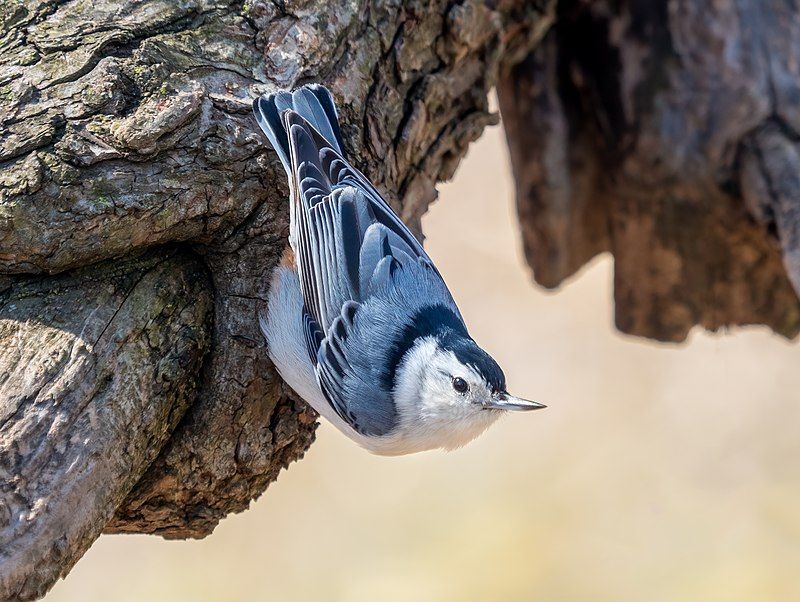
The White-Breasted Nuthatch, Sitta carolinensis, is a small bird with a striking appearance, characterized by its white face and underparts, blue-gray upperparts, and a black cap.
Known for their unique behavior of climbing down tree trunks headfirst, these birds inhabit deciduous and mixed forests across North America.
They have a distinctive nasal call and are often seen foraging for insects and seeds, which they wedge into tree bark to eat.
White-Breasted Nuthatches are also known for caching food for later use. Their agility and habit of probing tree bark for food make them a fascinating species to observe.
They are common visitors to bird feeders, where they are often seen grabbing a seed and flying off to eat it or store it in a crevice.
| Kingdom | Animalia |
| Phylum | Chordata |
| Clade | Dinosauria |
| Class | Aves |
| Order | Passeriformes |
| Family | Sittidae |
| Genus | Sitta |
| Species | S. carolinensis |
30. Red Crossbill (Loxia curvirostra)
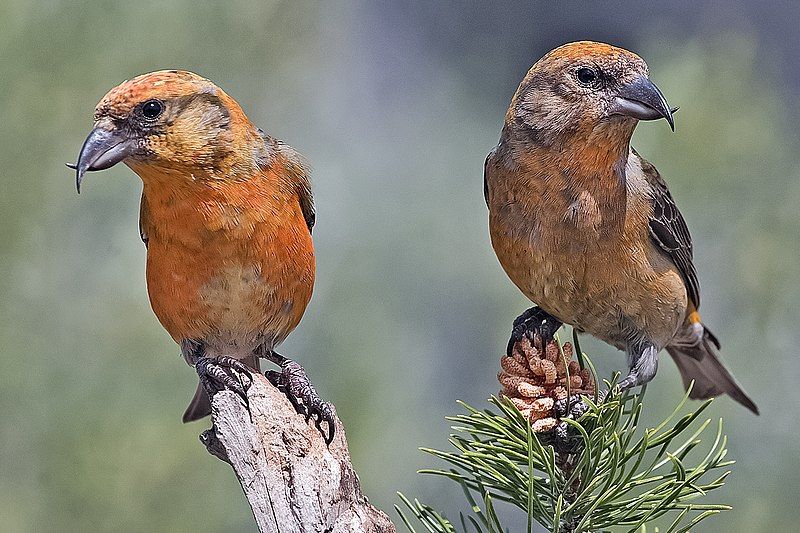
The Red Crossbill, Loxia curvirostra, is a medium-sized finch notable for its crossed bill tips, an adaptation for extracting seeds from conifer cones. Males are typically bright red with darker wings and tails, while females are olive-green.
This unique bill shape allows them to exploit a food source inaccessible to many other birds. Red Crossbills are nomadic, moving around in search of abundant cone crops.
Their calls are distinctive, consisting of a series of sharp notes. These birds are often observed in flocks in coniferous forests, and their breeding season is tied to the availability of cone seeds, making their reproductive timing highly variable.
| Kingdom | Animalia |
| Phylum | Chordata |
| Clade | Dinosauria |
| Class | Aves |
| Order | Passeriformes |
| Family | Fringillidae |
| Genus | Loxia |
| Species | L. curvirostra |
31. Pine Grosbeak (Pinicola enucleator)

The Pine Grosbeak, Pinicola enucleator, is a large finch family member found in coniferous forests across the northern hemisphere. Males have a striking rosy-red plumage, while females are more subdued with gray and yellow-green coloration.
These birds have a robust body and a thick bill suited for their diet of seeds and buds, particularly from conifers, as well as fruits and insects.
Pine Grosbeaks are known for their sweet, melodious song, which can be heard during the breeding season.
They are relatively tame and approachable, often allowing close observation. In winter, they may descend to lower elevations and visit bird feeders.
| Kingdom | Animalia |
| Phylum | Chordata |
| Clade | Dinosauria |
| Class | Aves |
| Order | Passeriformes |
| Family | Fringillidae |
| Genus | Pinicola |
| Species | P. enucleator |
32. Sharp-Shinned Hawk (Accipiter striatus)
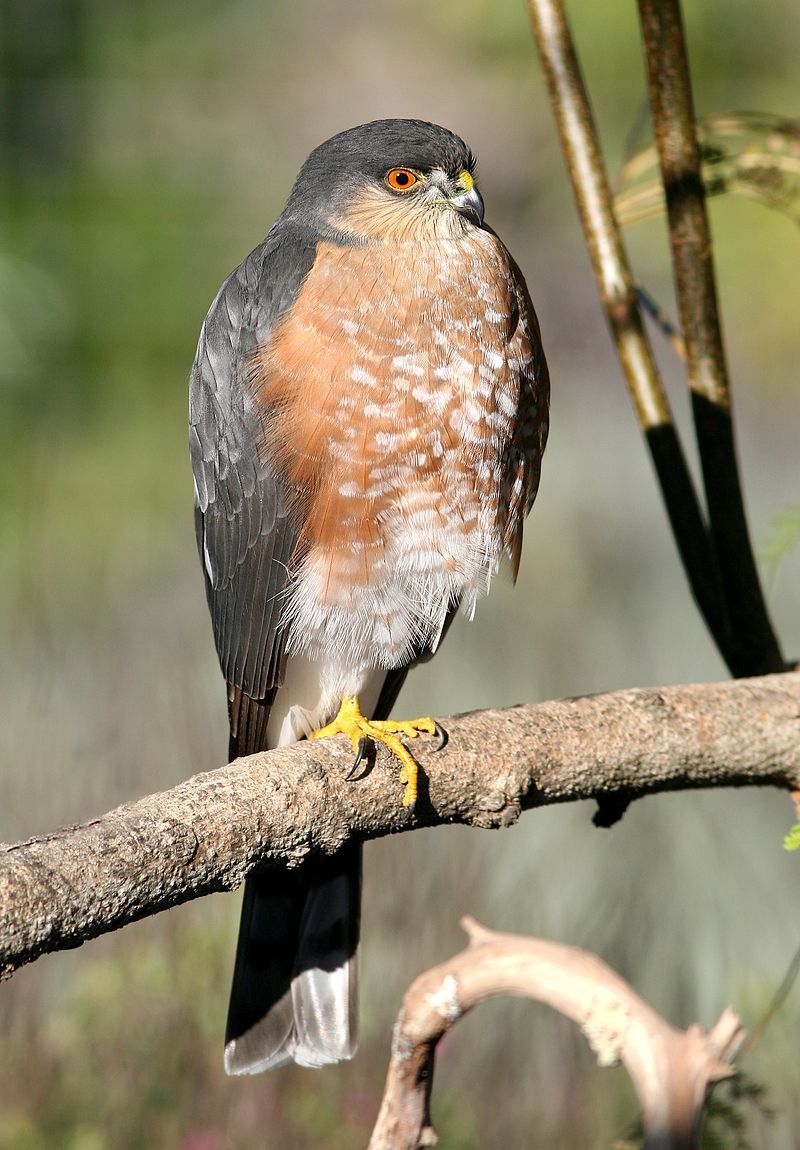
The Sharp-Shinned Hawk, Accipiter striatus, is the smallest hawk in North America. This bird has short, rounded wings and a long tail, typical of accipiters, making it highly maneuverable through dense forests.
Adults have slate gray upperparts and finely barred red-orange underparts, while juveniles are brown with streaked underparts.
Sharp-shinned hawks are adept hunters, preying primarily on small birds, which they catch in mid-air with bursts of speed.
They are often seen darting through woodlands or near bird feeders, looking for an unsuspecting meal. Their presence is usually revealed by the alarm calls of other birds.
| Kingdom | Animalia |
| Phylum | Chordata |
| Clade | Dinosauria |
| Class | Aves |
| Order | Accipitriformes |
| Family | Accipitridae |
| Genus | Accipiter |
| Species | A. striatus |
33. Northern Harrier (Circus hudsonius)
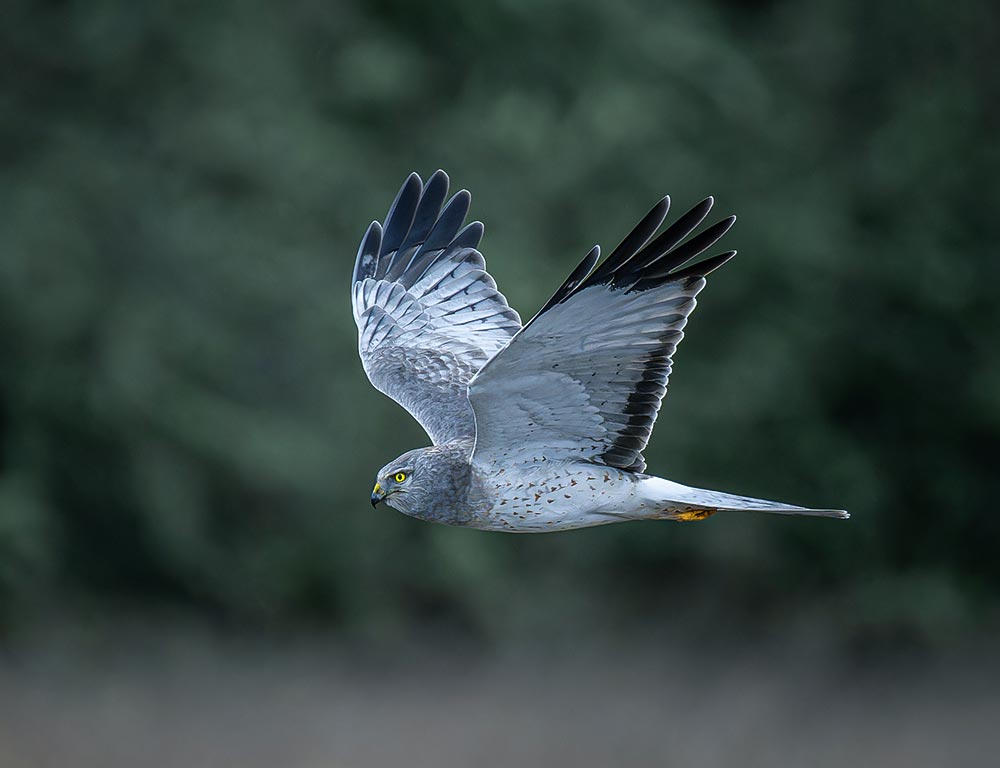
The Northern Harrier, Circus hudsonius, is a distinctive bird of prey known for its long wings and tail and a white patch on the rump, visible in flight. The male is gray, while the female is brown with streaks.
Unique among hawks, Northern Harriers have a facial disc similar to owls, which helps them hunt by sound and sight.
They are commonly found in open habitats like marshes, grasslands, and fields, where they fly low over the ground, searching for small mammals and birds.
Northern Harriers are known for their acrobatic flight and characteristic hovering behavior. They build their nests on the ground, often in dense vegetation.
| Kingdom | Animalia |
| Phylum | Chordata |
| Clade | Dinosauria |
| Class | Aves |
| Order | Accipitriformes |
| Family | Accipitridae |
| Genus | Circus |
| Species | C. hudsonius |
34. Cooper’s Hawk (Accipiter cooperii)
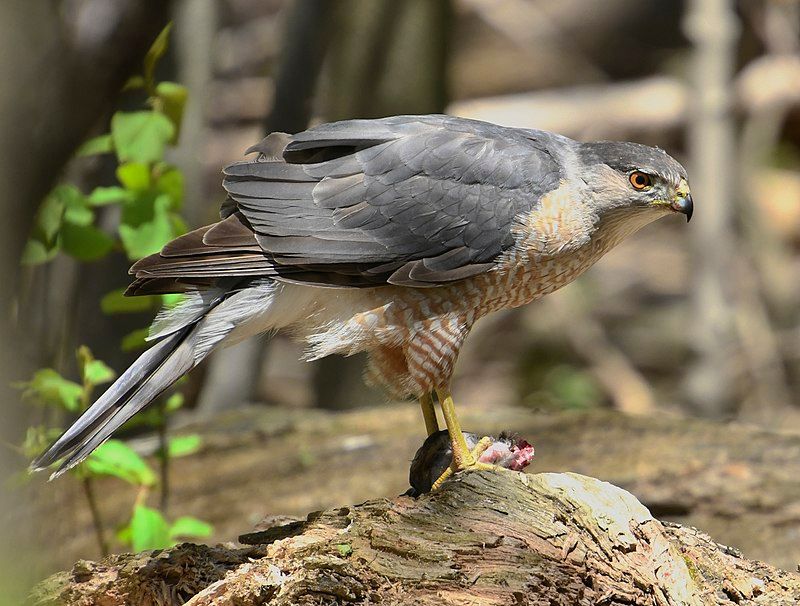
| Kingdom | Animalia |
| Phylum | Chordata |
| Clade | Dinosauria |
| Class | Aves |
| Order | Accipitriformes |
| Family | Accipitridae |
| Genus | Accipiter |
| Species | A. cooperii |
35. Eastern Screech Owl (Megascops asio)
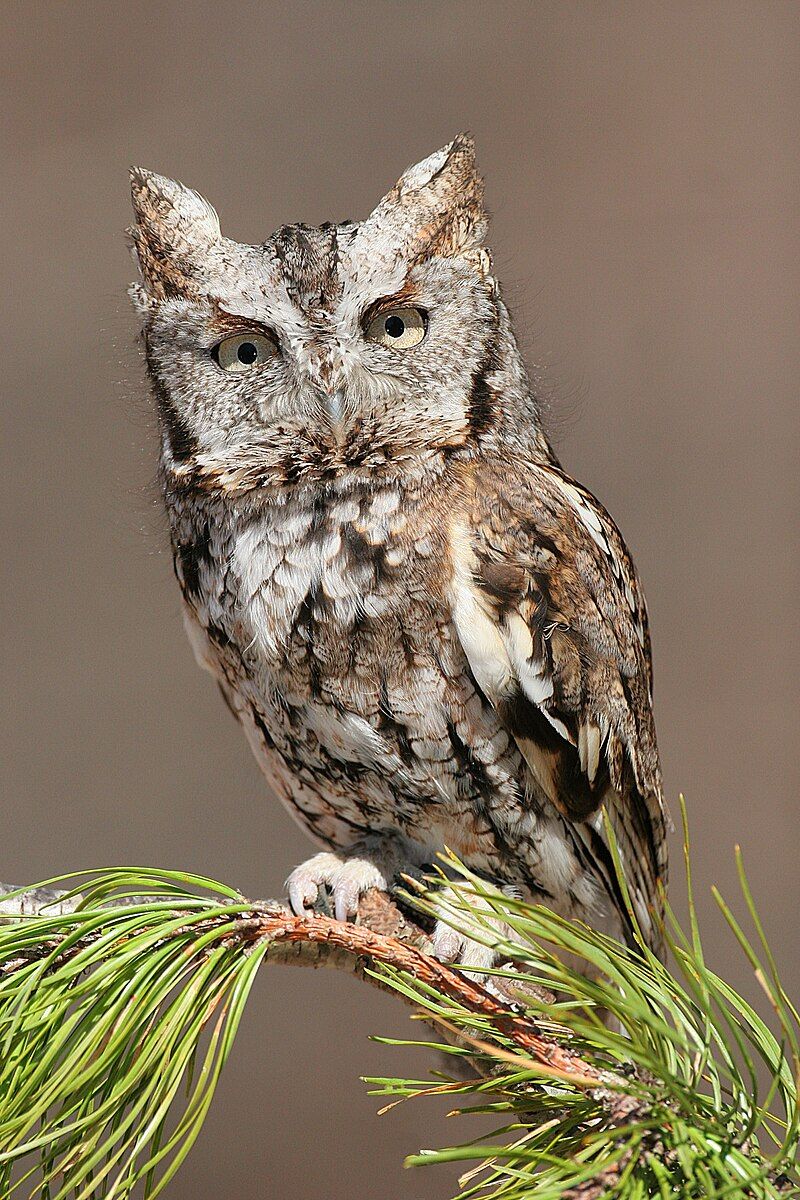
The Eastern Screech Owl, Megascops asio, is a small, nocturnal owl common in eastern North America. They exhibit two color morphs – gray or reddish-brown – which provide excellent camouflage against tree bark.
These owls have a rounded body, large head, yellow eyes, and distinctive ear tufts. They inhabit a variety of wooded environments and are often found near human habitations.
Eastern Screech Owls are opportunistic hunters, preying on a wide variety of small animals, including insects, rodents, and small birds.
Their calls vary from a soft, mournful whinny to a trilling sound. Despite their name, they rarely screech. These owls are cavity nesters, often using tree holes or nest boxes provided by humans.
| Kingdom | Animalia |
| Phylum | Chordata |
| Clade | Dinosauria |
| Class | Aves |
| Order | Strigiformes |
| Family | Strigidae |
| Genus | Megascops |
| Species | M. asio |
36. Merlin (Falco columbarius)

The Merlin Falco columbarius is a small, fierce falcon found across the northern hemisphere. They have a compact build with pointed wings and a relatively long tail.
Adult Merlins display a blue-gray back and wings in males and brown in females, with streaked underparts in both sexes. These birds are fast and agile fliers, often seen hunting small birds, which they catch in mid-air in dramatic chases.
Merlins are also known to hunt insects and small mammals. They breed in open and semi-open areas, often using old nests of other birds.
Merlins can be found in various habitats in winter, including coastal areas, wetlands, and urban environments. Their sharp, high-pitched call is typically heard during the breeding season.
| Kingdom | Animalia |
| Phylum | Chordata |
| Clade | Dinosauria |
| Class | Aves |
| Order | Falconiformes |
| Family | Falconidae |
| Genus | Falco |
| Species | F. columbarius |
37. Steller’s Jay (Cyanocitta stelleri)
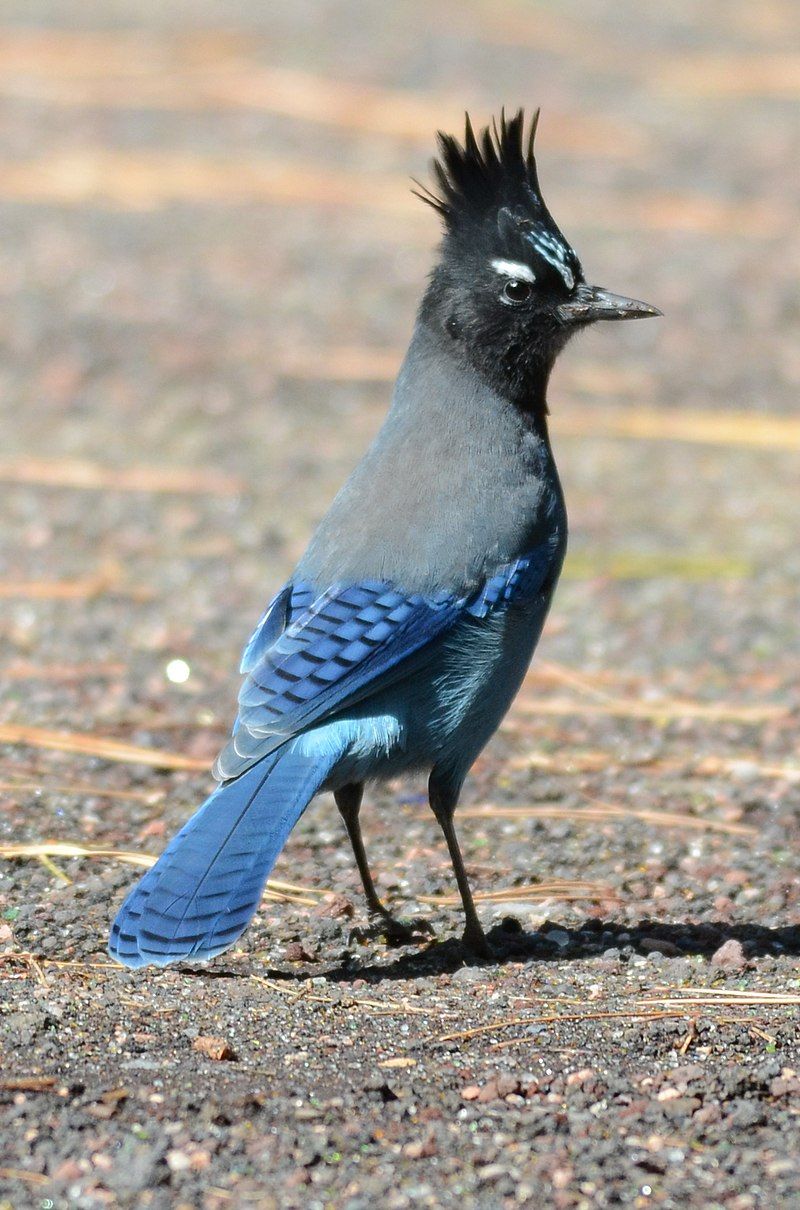
Steller’s Jay, Cyanocitta stelleri, is a striking and intelligent bird native to western North America. This jay is easily identified by its deep blue and black plumage and distinctive crest on its head.
Steller’s Jays are loud and assertive, known for their wide range of vocalizations, including imitations of other birds and human-made sounds.
They are omnivorous, feeding on nuts, seeds, insects, and occasionally small animals, and are also known to raid campsites and picnic areas for food.
These birds are common in forested habitats, from coastal rainforests to mountain pine forests. Steller’s Jays are highly social and are often seen in pairs or small groups.
| Kingdom | Animalia |
| Phylum | Chordata |
| Clade | Dinosauria |
| Class | Aves |
| Order | Passeriformes |
| Family | Corvidae |
| Genus | Cyanocitta |
| Species | C. stelleri |
38. Common Redpoll (Acanthis flammea)
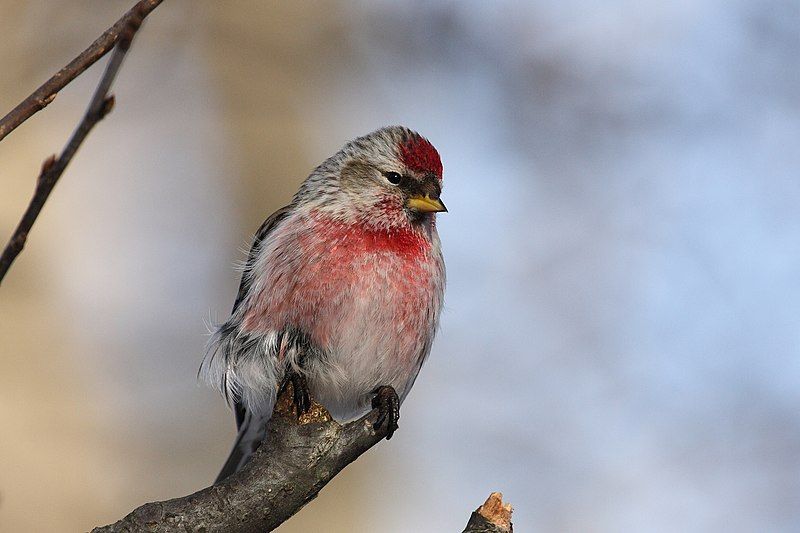
The Common Redpoll, Acanthis flammea, is a small finch with a distinctive red cap and black chin found in the northern regions of North America and Eurasia.
Their bodies are streaked with brown and white, and males have a rosy flush on their breasts. Common Redpolls are adapted to cold climates and can be found in open, scrubby areas, often visiting bird feeders in the winter.
They feed mainly on seeds, particularly from birches and alders. These birds are known for their energetic behavior and social nature, often seen in flocks. Their flight is undulating, and they have a pleasant, twittering song.
| Kingdom | Animalia |
| Phylum | Chordata |
| Clade | Dinosauria |
| Class | Aves |
| Order | Passeriformes |
| Family | Fringillidae |
| Genus | Acanthis |
| Species | A. flammea |
39. Lesser Goldfinch (Spinus psaltria)
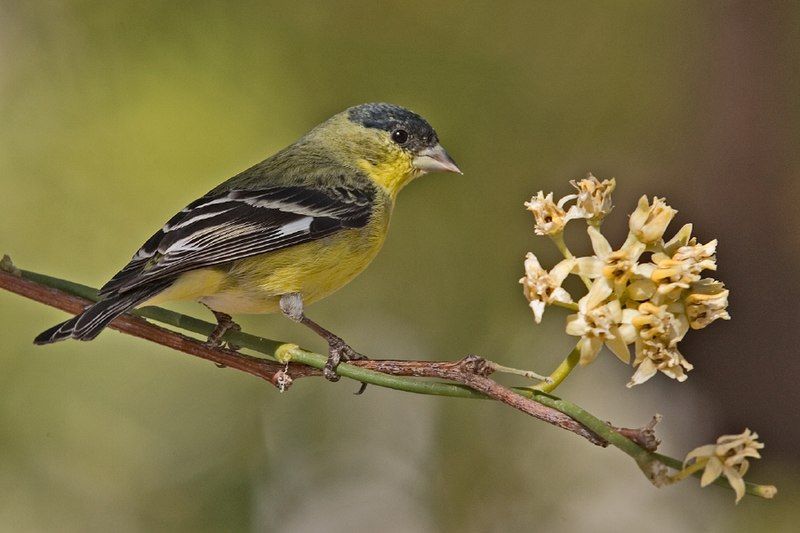
The Lesser Goldfinch, Spinus psaltria, is a small, vibrant finch found in the southwestern United States and parts of Central and South America.
Males look strikingly with a black cap, bright yellow underparts, and greenish-black back, while females are more muted with olive-yellow underparts and olive backs.
These finches inhabit open woodlands, gardens, and scrubby areas, feeding mainly on seeds and occasionally insects. They are often seen in small flocks, particularly around feeders and water sources.
Lesser Goldfinches have a sweet, warbling song and a high-pitched call, contributing to the lively soundscape of their habitats.
| Kingdom | Animalia |
| Phylum | Chordata |
| Clade | Dinosauria |
| Class | Aves |
| Order | Passeriformes |
| Family | Fringillidae |
| Genus | Spinus |
| Species | S. psaltria |
40. Canada Jay (Perisoreus canadensis)
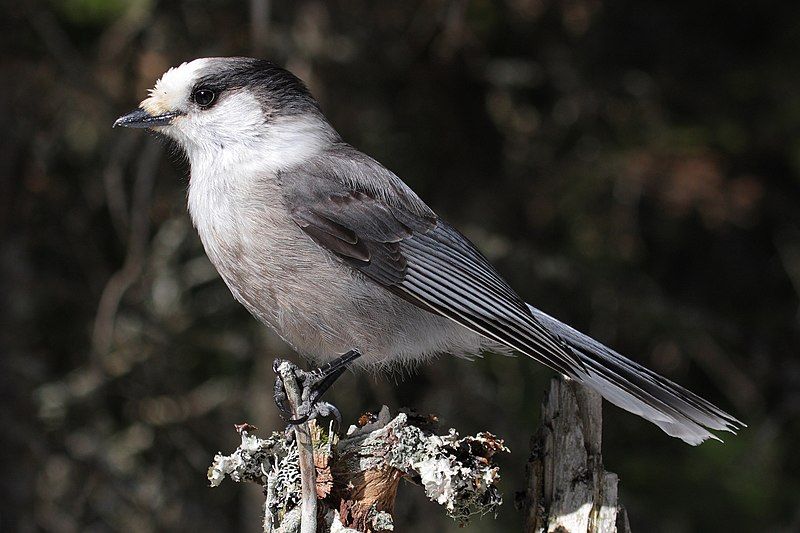
| Kingdom | Animalia |
| Phylum | Chordata |
| Clade | Dinosauria |
| Class | Aves |
| Order | Passeriformes |
| Family | Corvidae |
| Genus | Perisoreus |
| Species | P. canadensis |
41. Eurasian Goshawk (Accipiter gentilis)
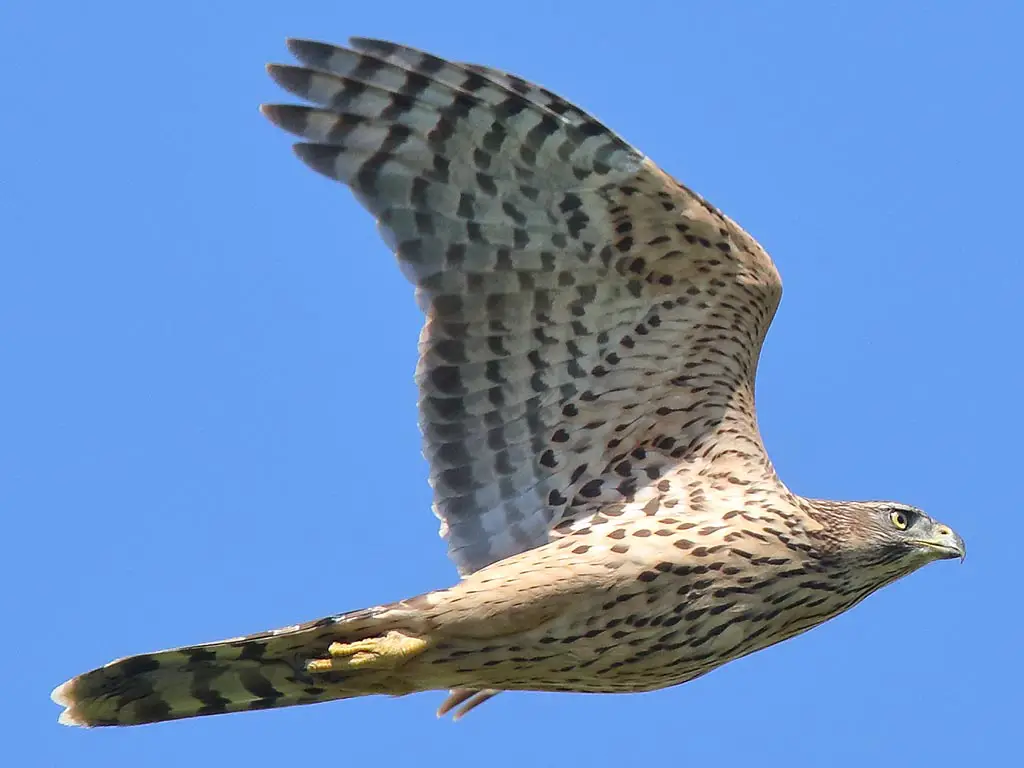
The Eurasian Goshawk, Accipiter gentilis, is a large, powerful raptor across Europe, Asia, and North America. They are characterized by their broad, rounded wings and long tails, which enable agile flight through dense woodlands.
Adult goshawks have blue-gray upperparts and barred gray underparts, while juveniles are brown with streaked underparts. These birds are apex predators, hunting various prey, including birds, mammals, and reptiles.
Their hunting strategy often involves a surprise attack, bursting through vegetation with remarkable speed and agility. Goshawks are secretive and tend to avoid human contact. They are known for fiercely defending their nest site, sometimes even against humans.
| Kingdom | Animalia |
| Phylum | Chordata |
| Clade | Dinosauria |
| Class | Aves |
| Order | Accipitriformes |
| Family | Accipitridae |
| Genus | Accipiter |
| Species | A. gentilis |
42. Ring-Necked Duck (Aythya collaris)
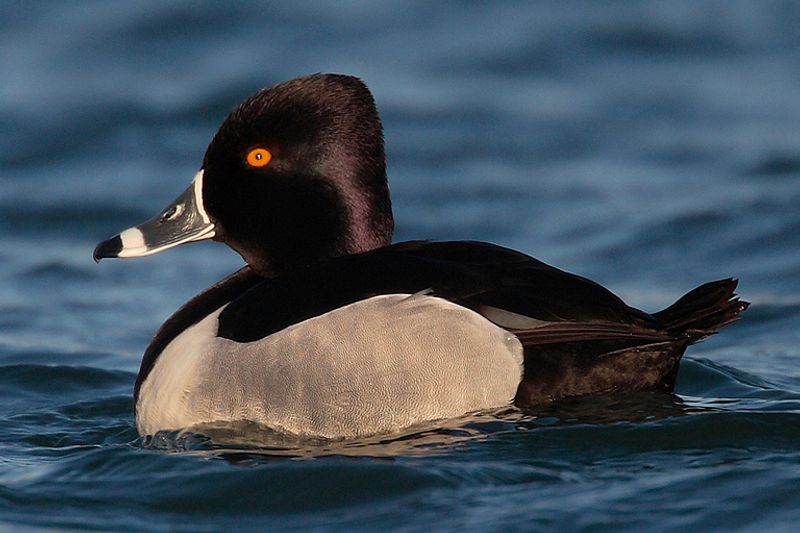
The Ring-Necked Duck, Aythya collaris, is a medium-sized diving duck with a distinctive ring around its neck, which is often difficult to see at a distance.
Males have a striking appearance with a glossy black head and back, a white ring around the base of their bill, and a light gray body, while females are brown with a white eye ring.
These ducks are found in freshwater lakes, ponds, and rivers across North America, particularly during migration and winter.
They feed primarily on aquatic vegetation, seeds, and invertebrates. Ring-necked ducks are known for their rapid, straight flight and are often seen in small flocks.
| Kingdom | Animalia |
| Phylum | Chordata |
| Clade | Dinosauria |
| Class | Aves |
| Order | Anseriformes |
| Family | Anatidae |
| Genus | Aythya |
| Species | A. collaris |
43. Ruffed Grouse (Bonasa umbellus)
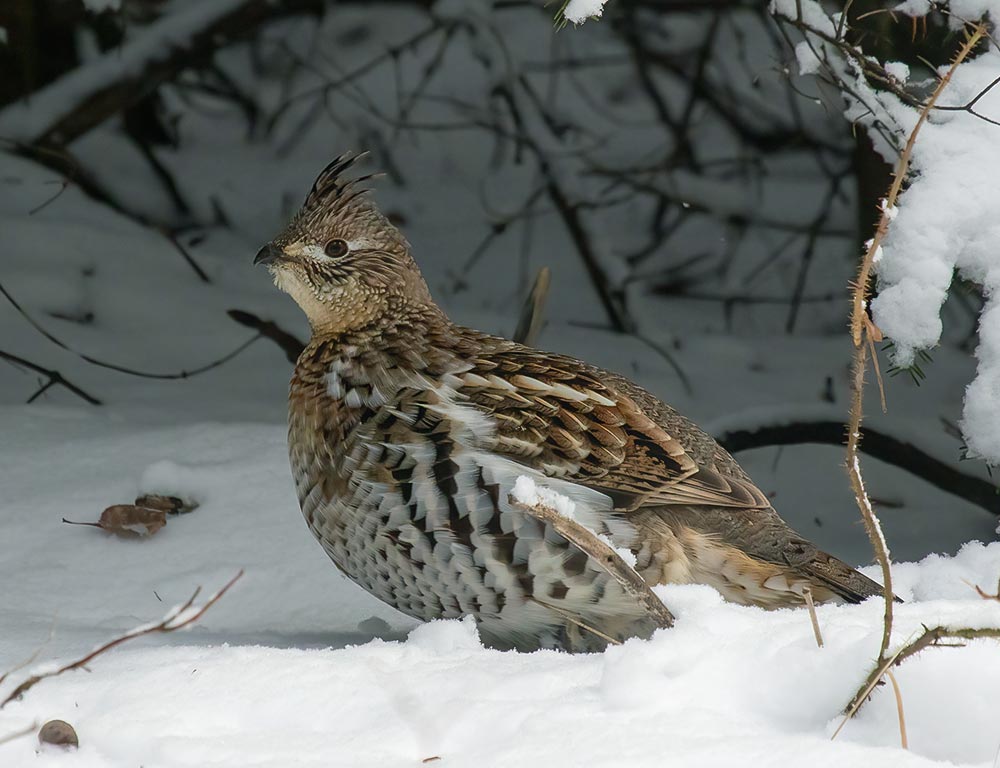
The Ruffed Grouse, Bonasa umbellus, is a medium-sized, forest-dwelling bird in North America, particularly in wooded areas.
They are well-camouflaged with mottled brown, black, gray, and white feathers, helping them blend into the forest floor.
The most striking feature is the ruff of black feathers around their neck, which are displayed during courtship.
Ruffed Grouse are known for their unique drumming display, which is produced by beating their wings in the air to create a low-frequency sound that resonates through the woods.
They feed on various foods, including buds, leaves, berries, and insects. Ruffed Grouse are solitary birds and can be difficult to spot due to their elusive nature.
| Kingdom | Animalia |
| Phylum | Chordata |
| Clade | Dinosauria |
| Class | Aves |
| Order | Galliformes |
| Family | Phasianidae |
| Genus | Bonasa |
| Species | B. umbellus |
44. Prairie Falcon (Falco mexicanus)
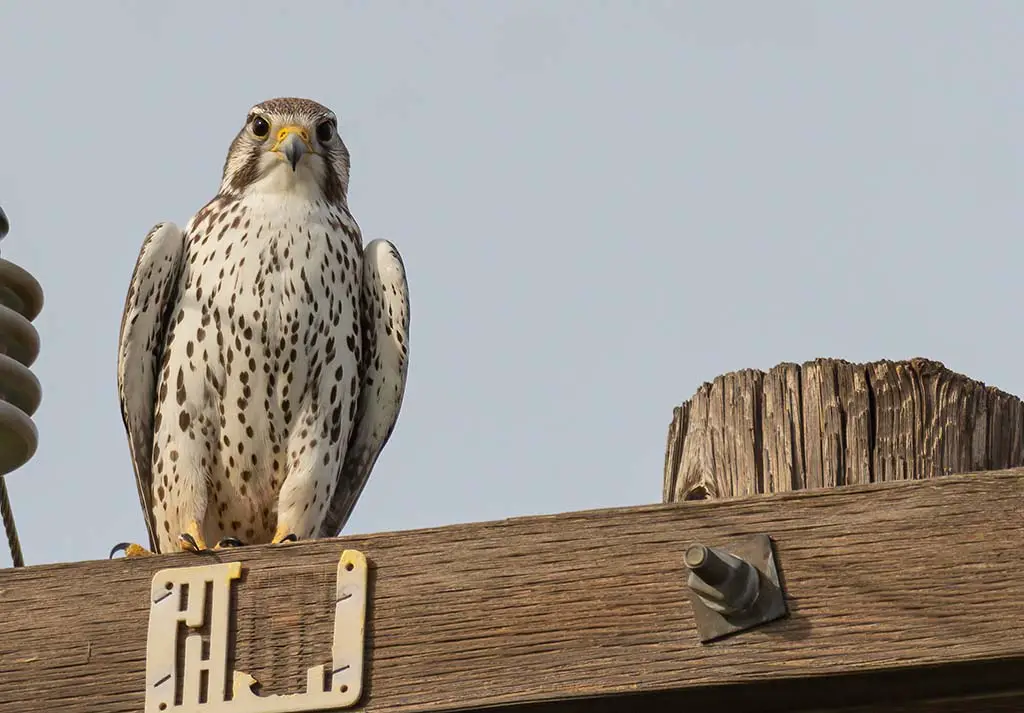
The Prairie Falcon, Falco mexicanus, is a medium-sized falcon of the open country in western North America. They have a pale brown back, with dark brown spots, and creamy underparts with brown streaks.
Their wings are long and pointed, characteristic of falcons, and they have a distinctive black “mustache” mark on their face. Prairie Falcons are agile fliers and hunt by fast, low-level pursuit or from a high perch, preying on small mammals and birds.
They are often seen in arid and semi-arid environments, including grasslands, deserts, and shrublands. Their call is a sharp “kree-kree-kree,” typically heard during aerial displays in the breeding season.
| Kingdom | Animalia |
| Phylum | Chordata |
| Clade | Dinosauria |
| Class | Aves |
| Order | Falconiformes |
| Family | Falconidae |
| Genus | Falco |
| Species | F. mexicanus |
45. American Three-Toed Woodpecker (Picoides dorsalis)
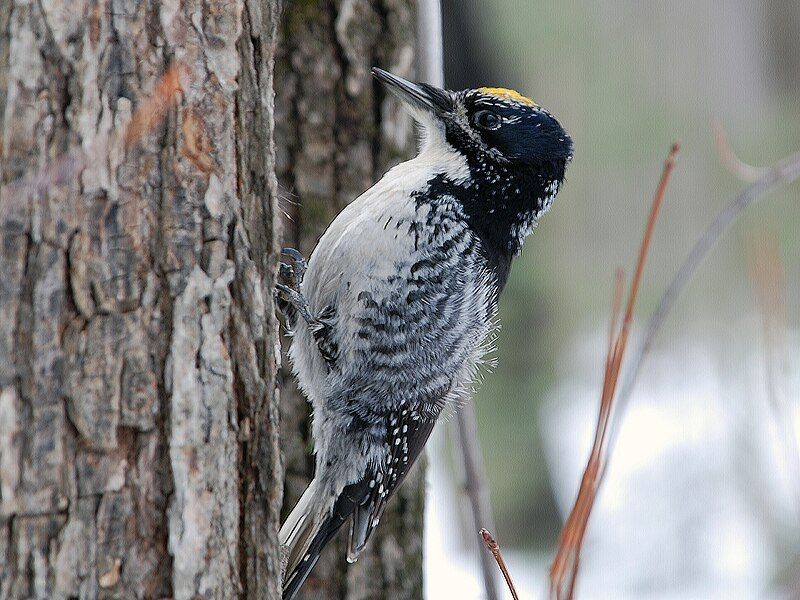
| Kingdom | Animalia |
| Phylum | Chordata |
| Clade | Dinosauria |
| Class | Aves |
| Order | Piciformes |
| Family | Picidae |
| Genus | Picoides |
| Species | P. dorsalis |
46. Ruby-Throated Hummingbird (Archilochus colubris)
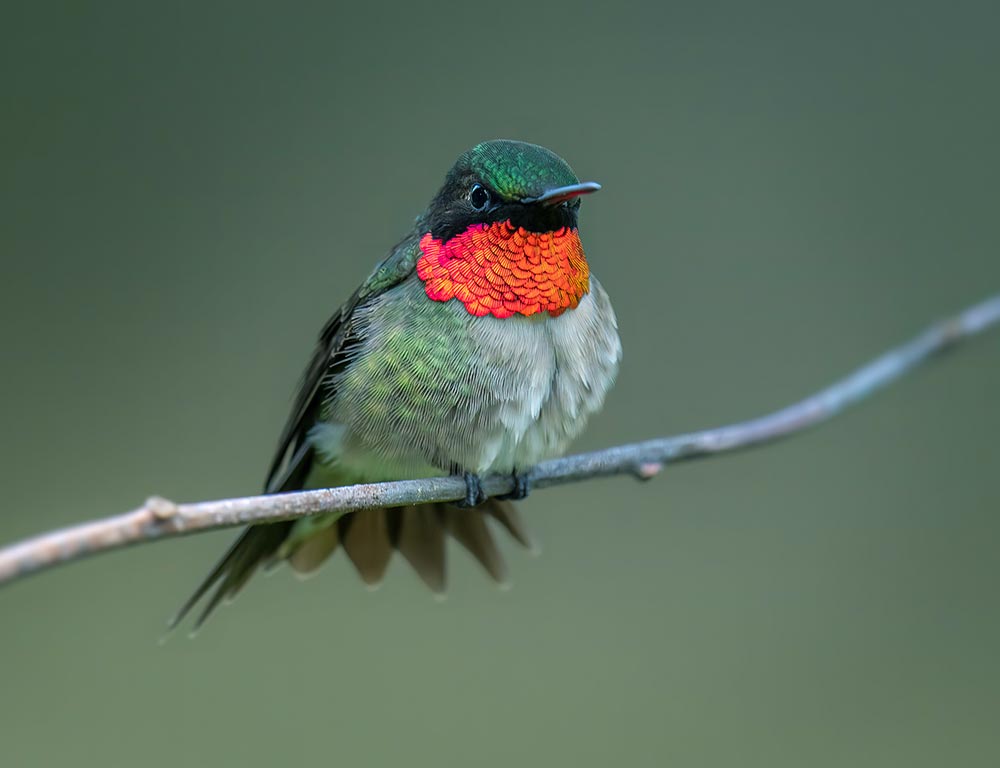
The Ruby-Throated Hummingbird, Archilochus colubris, is the most common hummingbird found in eastern North America. These tiny, vibrant birds are known for their iridescent green upperparts and the males’ distinctive ruby-red throats.
Females are less colorful, with white underparts and a green-speckled throat. Ruby-throated hummingbirds are renowned for their incredible flight abilities, including hovering and flying backward, enabled by their rapid wingbeats.
They primarily feed on nectar from flowers using their long, extendable tongues and consume small insects and spiders for protein.
They make a remarkable non-stop journey across the Gulf of Mexico during migration. Their presence in gardens, where they are often attracted to red, tubular feeders, makes them a favorite among birdwatchers.
| Kingdom | Animalia |
| Phylum | Chordata |
| Clade | Strisores |
| Class | Aves |
| Order | Apodiformes |
| Family | Trochilidae |
| Genus | Archilochus |
| Species | A. colubris |
47. Barn Swallow (Hirundo rustica)
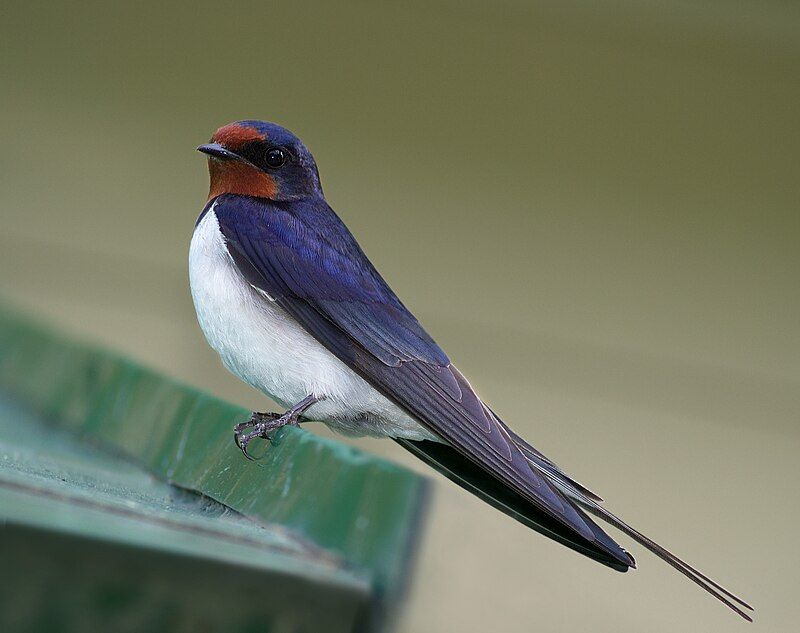
The Barn Swallow, Hirundo rustica, is a widespread and easily recognizable bird, known for its glossy blue upperparts, long forked tail, and orange-brown underparts.
They are the most widespread species of swallow in the world, found throughout North America and across other continents.
Barn Swallows are agile fliers, often seen swooping over fields and water bodies to catch insects mid-flight, constituting their primary diet.
They are closely associated with human habitation and often build their cup-shaped mud nests on man-made structures, including barns and bridges.
The birds are social and usually found in colonies. Their cheerful twittering and aerial acrobatics make them a delight to observe.
Barn Swallows also play a significant role in controlling insect populations, making them beneficial to have around farms and fields.
| Kingdom | Animalia |
| Phylum | Chordata |
| Clade | Dinosauria |
| Class | Aves |
| Order | Passeriformes |
| Family | Hirundinidae |
| Genus | Hirundo |
| Species | H. rustica |
Conclusion
The study of birds like the Ruby-Throated Hummingbird and the Barn Swallow opens a window into nature’s intricate and interconnected world.
With their unique adaptations and behaviors, these birds are not just spectacles of beauty and agility but also vital components of their ecosystems.
They contribute to pollination, insect control, and the overall balance of our natural environment. Their presence reminds us of the delicate balance of our ecosystems and the importance of preserving natural habitats.
As we continue to learn and marvel at these avian wonders, we are also reminded of our responsibility to protect and sustain the natural world for future generations to cherish and enjoy.